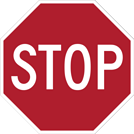 |
STOP SIGN (R1-1) (a) Justification. The Stop Sign (R1-1) is authorized for use on those streets or highways which intersect with a through highway or at a stop intersection so designed by the Department of Transportation with reference to State- designated highways or local authorities with reference to highways under their jurisdiction. The R1-1 sign is also authorized for use in work zones involving one-lane, two-way roadways. At intersections where all approaches are controlled by an R1-1 sign, a supplemental ALL-WAY Plaque (R1-3P) shall be mounted below each R1-1 sign. (b) Authorization. Before local authorities designate any highway as a through highway or stop intersection which will intersect or affect a State-designated highway, approval of such designation shall first be obtained from the Department of Transportation. Approval to install R1-1 signs in work areas shall not require the approval of the Department of Transportation or local authorities when the conditions stipulated in the Department of Transportation's Temporary Traffic Control Guidelines are satisfied. (c) Size. The standard size R1-1 sign shall be 30 inches x 30 inches for single lane conventional highways and 36 inches x 36 inches for multi-lane conventional highways. The 24 inches x 24 inches size shall only be used for alleys with restrictive physical conditions and vehicle usage that prohibits the installation of the standard size R1-1. A sign that is mounted back-to-back with a R1-1 sign should stay within the edges of the R1-1. If necessary, the size of the R1-1 sign should be increased so that any other sign installed back-to-back with it remains within the edges of the R1-1 sign. |
 |
RIGHT LANE KEEP MOVING SIGN (R1-1A) (a) Justification. The Right Lane Keep Moving Sign (R1-1A) may be used at a signalized intersection where the right-turn lane is channelized through the turn and becomes an added lane on intersecting roadway. (b) Placement. When used, the R1-1A sign should be positioned on the right side of the applicable lane. |
 |
RAMP SIGN (R1-1-2) The Ramp Sign (R1-1-2) may be used with a temporary Stop Sign (R1-1) installed on a ramp to control ramp traffic in a construction area. When used, the R1-1-2 sign shall be installed directly above the Stop Sign. The 36 inches x 18 inches sign is to be used with a 36 inches x 36 inches Stop Sign and the 48 inches x 24 inches sign is to used with a 48 inches x 48 inches Stop Sign. |
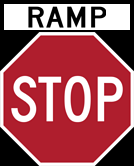 |
RAMP STOP SIGN (R1-1-3) The Ramp Stop Sign (R1-1-3) shall be used in work zone traffic control situations that require roll up signs. |
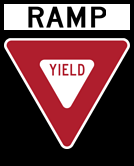 |
RAMP YIELD SIGN (R1-1-4) The Ramp Yield Sign (R1-1-4) shall be used in work zone traffic control situations that require roll up signs. |
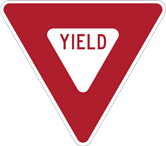 |
YIELD SIGN (R1-2) (a) Justification. The Yield Sign (R1-2) shall be authorized for use when it is necessary to assign the right-of-way but when a full stop is not necessary at all times; however, it should not be used when an adequate acceleration lane is provided. For a yield-controlled channelized right-turn movement onto a roadway without an acceleration lane and for an entrance ramp onto a freeway or expressway without an acceleration lane, a No Merge Area (W4-5P) supplemental plaque may be mounted below a R1-2 sign when engineering judgment indicates that road users would expect an acceleration lane to be present. (b) Size. The standard size of the R1-2 sign for single lane conventional highways shall be 36 inches per side. The minimum size for multi-lane conventional highways and expressways shall be 48 inches per side. A sign mounted back-to-back with a R1-2 should stay within the edges of the R1-2 sign. If necessary, the size of the R1-2 sign should be increased so that any other sign installed back-to-back with it remains within the edges of the R1-2 sign. |
 |
TO ONCOMING TRAFFIC SIGN (R1-2AP) The To Oncoming Traffic Sign (R1-2AP) may be used in conjunction with a Yield Sign (R1-2) and yield markings when placed prior to one-lane bridge or a one-lane underpass. When used, the R1-2AP sign shall be mounted below the Yield Sign (R1-2). |
| ALL WAY PLAQUE (R1-3P) (a) Justification. The All Way Plaque (R1-3P) shall be used below the Stop Sign (R1-1) at multi-way stop intersections to indicate that all approaches are required to stop. |
 |
STOP SIGN REMOVED FROM SIDE STREET SIGN (R1-4-1) (a) Justification.
(b) Placement. When used, the R1-4-1 sign shall be placed beneath appropriate stop signs for educational purposes. |
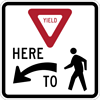 |
YIELD HERE TO PEDESTRIAN WITH LEFT ARROW SIGN (R1-5L) (a) Justification. The Yield Here to Pedestrian With Left Arrow Sign (R1-5L) shall be used on the right side of the roadway, adjacent to a yield line in advance of an unsignalized midblock crosswalk that crosses a multi-lane approach. The R1-5L sign may also be used on approaches to unsignalized midblock crosswalks even if yield lines are not used. (b) Placement. When used, the R1-5L sign and yield line should be installed 20 to 50 feet in advance of the nearest crosswalk line. If a Pedestrian Sign (W11-2) has been post-mounted at the crosswalk location where a R1-5L is used on the approach, the R1-5L sign shall not be placed on the same post as or block the road user's view of the W11-2 sign. |
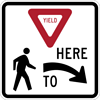 |
YIELD HERE TO PEDESTRIAN WITH RIGHT ARROW SIGN (R1-5L) (a) Justification. The Yield Here to Pedestrian With Right Arrow Sign (R1-5R) shall be used on the right side of the roadway, adjacent to a yield line in advance of an unsignalized midblock crosswalk that crosses a multi-lane approach. The R1-5R sign may also be used on approaches to unsignalized midblock crosswalks even if yield lines are not used. (b) Placement. When used, the R1-5R sign and yield line should be installed 20 to 50 feet in advance of the nearest crosswalk line. If a Pedestrian Sign (W11-2) has been post-mounted at the crosswalk location where a R1-5R is used on the approach, the R1-5R sign shall not be placed on the same post as or block the road user's view of the W11-2 sign. |
| IN-STREET PEDESTRIAN CROSSING SIGN (R1-6) (a) Justification. The In-Street Pedestrian Crossing Sign (R1-6) is authorized for use on the face of a Yield to Pedestrian Channelizing Device which may be positioned on the centerline of low-speed roadways in a marked unsignalized crosswalk to remind drivers that they must legally yield the right-of-way to pedestrians in the crosswalk. The Yield to Pedestrian Device shall satisfy national breakaway requirements and the Department of Transportation's specification, and be of a type approved by the Department of Transportation and listed in Bulletin 15. (b) Placement. When used, the R1-6 sign Yield to Pedestrian Device shall be placed in the roadway at the crosswalk location on the center line, on a lane line, or on a median island. It should not be positioned on roadways with a speed limit greater than 35 MPH or with a clear roadway width of less than 20 feet. In addition, it should not be used at locations where it will adversely affect the turning radius of motor vehicles. |

|
OVERHEAD PEDESTRIAN CROSSING SIGN (R1-9) (a) Justification. The Overhead Pedestrian Crossing sign (R1-9) may be used to remind road users of laws regarding right-of-way at an unsignalized crosswalk. The R1-9 sign may be modified to replace the standard pedestrian symbol with the standard school children symbol and may be used at unsignalized school crossings. (b) Placement. If used, the R1-9 sign shall be placed over the roadway at the crosswalk location. A R1-9 sign shall not be placed in advance of the crosswalk to educate road about the State law prior to reaching the crosswalk, nor shall it be installed as an educational display that is not near any crosswalk. The R1-9 sign shall not be used at signalized locations. |
 |
EXCEPT RIGHT TURN PLAQUE (R1-10P) (a) Justification. The Except Right Turn Plaque (R1-10P) will be authorized for use with a Stop Sign to allow right-turn movements without stopping at an intersection where the major flow of traffic makes a right-hand turn rather than proceeding straight through. Its use should be limited to those locations where a significant energy saving can be realized by minimizing the number of vehicles required to stop or substantially reduce their speed. Care should be taken to insure that no traffic conflicts exist. (b) Placement. When used, the R1-10P plaque shall be mounted below the Stop Sign (R1-1) on the approach with the heavy right-turn movement. |
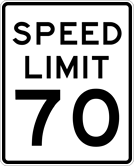 |
SPEED LIMIT SIGN (R2-1) The Speed Limit Sign (R2-1) shall be authorized for use to display the maximum legal speed limit on a highway. When used as a variable speed limit sign, speed display module(s) may be attached to the sign or inserted through cut-outs in the sign substrate. The R2-1 Sign shall be placed at intervals as specified in Department of Transportation regulations. The standard signs signs shall be as follows:
|
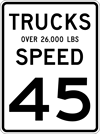 |
TRUCKS OVER (__) LBS. SPEED SIGN (R2-2-1) The Trucks Over (__) Lbs. Speed Sign (R2-2-1) may be used to indicate the hazardous grade speed limit for all trucks, or trucks over a designated weight. The words "OVER (__) LBS." the "S" in "TRUCKS" shall be eliminated and the legend reoriented if the restriction applies to all trucks. The R2-2-l sign may be erected along or in series with the Reduced Gear Zone Sign (R14-12) and shall be placed in accordance with Department of Transportation regulations (relating to hazardous grade speed limits). The size of the R2-2-1 sign should be 36 inches x 48 inches when used at the beginning of the zone. When used within the zone, the standard size should be 30 inches x 36 inches. |
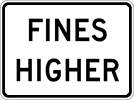 |
FINES HIGHER PLAQUE (R2-6P) The Fines Higher Plaque (R2-6P) shall be used to provide notice to road users if increased fines are imposed for traffic violations within a designated zone of a roadway. The R2-6P sign shall be mounted below an applicable regulatory or warning sign in a temporary traffic control zone, a school zone, or other applicable designated zone. If used, the R2-6P sign should be located at the beginning of the temporary traffic control zone, a school zone, or other applicable designated zone and just beyond any interchanges, major intersections, or other major traffic generators. The Fines Double Plaque (R2-6AP) may be used as an alternate to the R2-6P. If the R2-6P sign is posted to provide notice of increased fines for traffic violations, an End Higher Fines Zone Sign (R2-11) shall be installed at the downstream end of the zone to provide notice to road users of the termination of the increased fines zone. |
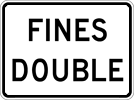 |
FINES DOUBLE PLAQUE (R2-6AP) The Fines Double Plaque (R2-6AP) shall be used to provide notice to road users if fines are imposed for traffic violations within a designated zone of a roadway. The R2-6AP sign shall be mounted below an applicable regulatory or warning sign in a temporary traffic control zone, a school zone, or other applicable designated zone. If used, the R2-6AP sign should be located at the beginning of the temporary traffic control zone, a school zone, or other applicable designated zone and just beyond any interchanges, major intersections, or other major traffic generators. The Fines Higher Plaque (R2-6P) may be used as an alternate to the R2-6AP. If the R2-6AP sign is posed to provide notice of increased fines for traffic violations, an End Double Fines Zone Sign (R2-11) shall be installed at the downstream end of the zone to provide notice to road users of the termination of the increased fines zone. |
 |
NEXT (__) SIGN (R2-9) The Next (__) Sign (R2-9) may be used beneath any regulatory sign to show the distance to the end of the restriction. The distance may be shown in feet or miles. |
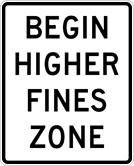 |
BEGIN HIGHER FINES ZONE SIGN (R2-10) The Begin Higher Zone Sign (R2-10) shall be used to provide notice to road users if increased fines are imposed for traffic violations within a designated zone of a roadway. If used, the R2-10 sign should be located the beginning of the temporary traffic control zone, a school zone, or other applicable designated zone and just beyond any interchanges, major intersections or other major traffic generators. The alternate legend BEGIN DOUBLE FINES ZONE may also be used for the R2-10 sign. If the R2-10 sign is posted to provide notice of increased fines for traffic violations, an End Higher Fines Zone Sign (R2-11) shall be installed at the downstream end of the zone to provide notice to road users of the termination of the increased fines zone. |
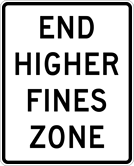 |
END HIGHER FINES ZONE SIGN (R2-11) The End Fines Zone Sign (R2-11) shall be installed at the downstream end of an applicable designated zone to provide notice to road users of the termination of the increased fines zone, if a Begin Higher Fines Zone Sign (R2-10), Fines Higher Plaque (R2-6P), or Fines Double Plaque (R2-6AP) is posed to provide notice of increased fines for traffic violations. The alternate legend END DOUBLE FINE ZONE may also be used for the R2-11 sign. |
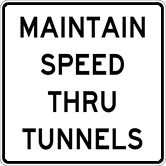 |
MAINTAIN SPEED THRU TUNNELS SIGN (R2-15) The Maintain Speed Thru Tunnels Sign (R2-15) may be used in advance of tunnels where a stopped or slow moving vehicle would create a potentially dangerous situation. If only one tunnel exists, the "S" should be eliminated on "TUNNELS" and the spacing readjusted. |
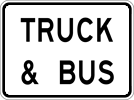 |
TRUCK AND BUS PLAQUE (R2-101) The Truck and Bus Plaque (R2-101) may used above a Speed Limit Sign (R2-1), a turn prohibition sign, or other appropriate regulatory sign in order to effect a restriction authorized as a result of an engineering and traffic study. When used, the R2-101 plaque should the same width as the regulatory sign it supplements. |
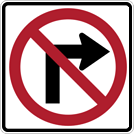 |
NO RIGHT TURN SIGN (R3-1) (a) Justification. The No Right Turn Sign (R3-1) shall be authorized to prohibit right turns. (b) Placement. The R3-1 sign shall be placed at the right-hand corner of the intersection. An auxiliary sign with the same message may be used in advance of the intersection. (c) Size. The standard size of the R3-1 sign for single lane conventional highways shall be 24 inches x 24 inches for post-mounted signs and 30 inches x 30 inches for overhead installations. The standard size for multi-lane conventional highways and for expressways shall be 36 inches x 36 inches. |
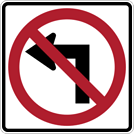 |
NO LEFT TURN SIGN (R3-2) (a) Justification. The No Left Turn Sign (R3-2) shall be authorized for use to prohibit left turns. (b) Placement.
(c) Size. The standard size of the R3-2 sign for single lane conventional highways shall be 24 inches x 24 inches for post-mounted signs and 30 inches x 30 inches for overhead installations. The standard size for multi-lane conventional highways and expressways shall be 36 inches x 36 inches. |
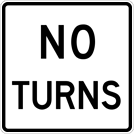 |
NO TURNS SIGN (R3-3) (a) Justification. The No Turns Sign (R3-3) shall be authorized for use to prohibit all turns. (b) Placement.
(c) Size. The standard size of the R3-3 sign for single lane conventional highways shall be 24 inches x 24 inches for post-mounted signs and 36 inches x 36 inches for overhead installations. The standard size for multi-lane conventional highways and expressways shall be 36 inches x 36 inches. |
 |
NO TURNS FROM SHOULDER SIGN (R3-3-3) The No Turns From Shoulder Sign (R3-3-3) may be used at locations where it is desired to prohibit vehicles from using the shoulder to make a right or left turn. The R3-3-3 sign should be placed in advance of and at the intersection or driveway where the turns are being made. |
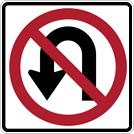 |
NO U-TURN SIGN (R3-4) (a) Justification. The No U-Turn Sign (R3-4) shall be authorized for use to prohibit U-Turns. (b) Placement. The R3-4 sign is placed at or between intersections to indicate that U-Turns at the specific intersection or on the roadway so posted are prohibited. The R3-4 shall not be used at approaches to roundabouts. (c) Size. The standard size of the R3-4 sign for single lane conventional highways shall be 24 inches x 24 inches. The standard size for multi-lane conventional highways and expressways shall be 36 inches x 36 inches. |
 |
STRAIGHT-THROUGH SIGN (R3-5A) (a) Justification. The Straight-Through Sign (R3-5A) shall be authorized for use to indicate that the lane beneath the sign may only go straight ahead at upcoming intersection. (b) Placement. The R3-5A sign shall be placed overhead above any lane of an approach to an intersection where traffic must proceed through the intersection without turning in any direction. |
 |
LEFT TURN SIGN (R3-5L) (a) Justification. The Left Turn Sign (R3-5L) shall be authorized for use to indicate that the lane beneath the sign may only turn left. (b) Placement. The R3-5L sign shall be placed overhead above the left lane or lanes of an approach to an intersection where traffic must turn to the left. |
 |
RIGHT TURN SIGN (R3-5R) (a) Justification. The Right Turn Sign (R3-5R) shall be authorized for use to indicate that the lane beneath the sign may only turn right. (b) Placement. The R3-5R sign shall be placed overhead above the right lane or lanes of an approach to an intersection where traffic must turn to the right. |
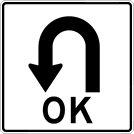 |
U-TURN OK SIGN (R3-5-1) The U-Turn OK Sign (R3-5-1) may be used as a lane use control sign to indicate that U-Turns are permissible. The R3-5-1 sign may be placed at or between intersections to indicate that U-Turns at the specific intersection or on the roadway so posted are permitted. The standard signs of the R3-5-1 sign for single lane conventional highways shall be 24 inches x 24 inches for post-mounted signs and 30 inches x 30 inches for overhead installations. The standard size for multi-lane conventional highways and expressways is 36 inches x 36 inches. |
 |
OPTIONAL LEFT OR RIGHT TURN SIGN (R3-6LR) (a) Justification. The Optional Left or Right Turn Sign (R3-6LR) shall be authorized for use in advance of an intersection to show that all traffic in the lane beneath the sign must turn either left or right. (b) Placement. The R3-6LR sign shall be placed overhead above any lane of an approach to an intersection where traffic must either turn left or right. |
 |
OPTIONAL LEFT TURN SIGN (R3-6LS) (a) Justification. The Optional Left Turn Sign (R3-6LS) shall be authorized for use in advance of an intersection to show that all traffic in the lane beneath the sign must either turn left or proceed straight through the intersection. (b) Placement. The R3-6LS sign shall be placed overhead above any lane of an approach to an intersection where traffic must either turn left or proceed straight through. |
 |
OPTIONAL LEFT, STRAIGHT, AND RIGHT TURN SIGN (R3-6LSR) (a) Justification. The Optional Left, Straight, and Right Turn Sign (R3-6LSR) may be used on multiple lane approaches where an adjacent lane is required to turn left or right. (b) Placement. When used, the R3-6LSR sign shall be placed overhead above the appropriate lane. |
 |
OPTIONAL RIGHT TURN SIGN (R3-6SR) (a) Justification. The Optional Right Turn Sign (R3-6SR) shall be authorized for used in advance of an intersection to advise that all traffic in the lane beneath the sign must turn right or proceed straight through the intersection. (b) Placement. The R3-6SR sign shall be placed above any lane of an approach to an intersection where traffic must either proceed straight through or turn right. |
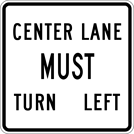 |
CENTER LANE MUST TURN LEFT SIGN (R3-7C) The Center Lane Must Turn Left Sign (R3-7C) may be used on five-lane highways when traffic in the center lane must turn left and and neither the R3-9A sign nor the R3-9B sign is applicable. The standard size of the R3-7C sign for single lane conventional highways shall be 30 inches x 30 inches. The standard size for multi-lane conventional highways shall be 36 inches x 36 inches. |
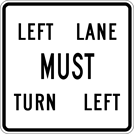 |
LEFT LANE MUST TURN LEFT SIGN (R3-7L) The Left Lane Must Turn Left Sign (R3-7L) may be used to advise motorists that all vehicles in the left lane must turn left. When used, the R3-7L sign should be placed an adequate distance in advance of the intersection when traffic in the left lane of an approach to an intersection must turn left. The sign may also be placed at the intersection as a supplement to the Left Turn Sign (R3-5L). The standard size of the R3-7L sign for single lane conventional highways shall be 30 inches x 30 inches. The standard size for multi-lane conventional highways shall be 36 inches x 36 inches. |
 |
LEFT LANE MUST TURN LEFT SIGN (R3-7LA) The Left Lane Must Turn Left Sign (R3-7LA) may be used instead of the 30 inches x 30 inches R3-7L sign. It may be especially appropriate where a narrow sign is required in an area of restricted width. When used, the R3-7LA sign should be placed an adequate distance in advance of the intersection when traffic in the left lane of an approach to an intersection must turn left. The sign may also be placed at the intersection as a supplement to the Left Turn Sign (R3-5L). |
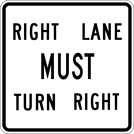 |
RIGHT LANE MUST TURN RIGHT SIGN (R3-7R) The Right Lane Must Turn Right Sign (R3-7R) may be used to advise motorists that all vehicles in the right lane must turn right. When used, the R3-7R sign should be placed an adequate distance in advance of the intersection when traffic in the right lane of an approach to an intersection must turn right. The sign may also be placed at the intersection as a supplement to the Right Turn Sign (R3-5R). The standard size of the R3-7R sign for single lane conventional highways shall be 30 inches x 30 inches. The standard size for multi-lane conventional highways shall be 36 inches x 36 inches. |
 |
RIGHT LANE MUST TURN RIGHT SIGN (R3-7RA) The Right Lane Must Turn Right Sign (R3-7RA) may be used instead of the 30 inches x 30 inches R3-7R sign. It may be especially appropriate where a narrow sign is required in an area of restricted width. When used, the R3-7RA sign should be placed an adequate distance in advance of the intersection when traffic in the right lane of an approach to an intersection must turn right. The sign may also be placed at the intersection as a supplement to the Right Turn Sign (R3-5R). |
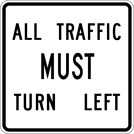 |
ALL TRAFFIC MUST TURN LEFT SIGN (R3-7-1L) The All Traffic Must Turn Left Sign (R3-7-1L) may be used when traffic in all lanes of an approach to an intersection must turn left and may also be used as a supplement to the overhead Left Turn Sign (R3-5L). When used, the R3-7-1L sign should be placed at the intersection with a second sign an adequate distance in advance of the intersection. When used as a supplement to the R3-5L sign, it should be placed an adequate distance in advance of the intersection. The standard size of the R3-7-1L sign for single lane conventional highways shall be 30 inches x 30 inches. The standard size for multi-lane conventional highways shall be 36 inches x 36 inches. |
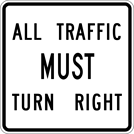 |
ALL TRAFFIC MUST TURN RIGHT SIGN (R3-7-1R) The All Traffic Must Turn Right Sign (R3-7-1R) may be used when traffic in all lanes of an approach to an intersection must turn right and may also be used as a supplement to the overhead Right Turn Sign (R3-5R). When used, the R3-7-1R sign should be placed at the intersection with a second sign an adequate distance in advance of the intersection. When used as a supplement to the R3-5R sign, it should be placed an adequate distance in advance of the intersection. The standard size of the R3-7-1R sign for single lane conventional highways shall be 30 inches x 30 inches. The standard size for multi-lane conventional highways shall be 36 inches x 36 inches. |
 |
LANE MUST TURN SUPPLEMENTARY PLAQUE (R3-7-2) (a) Justification. The Lane Must Turn Supplementary Plaque (R3-7-2) may be used with the Left Lane Must Turn Left Sign (R3-7L) or the Right Lane Must Turn Right Sign (R3-7R) to indicate that traffic in the designated lane must turn into one of the streets indicated on the R3-7-2 sign. (b) Placement. The R3-7-2 sign shall be placed below the R3-7L or R3-7R signs. |

|
LANE USE CONTROL (TWO LANES) SIGN (R3-8A) The Lane Use Control (Two Lanes) Sign (R3-8A) may be used on a two-lane approach to an intersection. The R3-8A sign can be designed using appropriate lane use symbols to depict actual site conditions. Other symbol combinations are also acceptable. When used, the R3-8A should be mounted an adequate distance in advance of the intersection to allow the motorist time to select the appropriate lane before reaching the intersection. The R3-8A sign may also be placed at the intersection or as a supplement to other lane use control signs. The R3-8A sign shall not be mounted overhead. |
 |
LANE USE CONTROL (THREE LANES) SIGN (R3-8B) The Lane Use Control (Three Lanes) Sign (R3-8B) may be used on a three-lane approach to an intersection. The R3-8B sign can be designed using appropriate lane use symbols to depict actual site conditions. Other symbol combinations are also acceptable. When used, the R3-8B should be mounted an adequate distance in advance of the intersection to allow the motorist time to select the appropriate lane before reaching the intersection. The R3-8B sign may also be placed at the intersection or as a supplement to other lane use control signs. The R3-8B sign shall not be mounted overhead. |
 |
TWO-WAY LEFT TURN ONLY SIGN (R3-9A) (a) Justification. The Two-Way Left Turn Only Sign (R3-9A) is authorized for overhead installations in conjunction with pavement markings to indicate that the lane has been reserved for the exclusive use of left turning vehicles. (b) Placement. When used, the R3-9A sign may be placed above the two-way left turn lane at the beginning of the zone and at intervals throughout. On three-lane roadways, the presence of the R3-9A sign shall also satisfy the requirement to identify the beginning of the no-passing zone. |
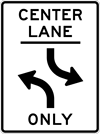 |
CENTER LANE — LEFT TURN ONLY SIGN (R3-9B) The Center Lane — Left Turn Only Sign (R3-9B) may be used as a post-mounted sign in conjunction with appropriate pavement markings to indicate that a designated "control" lane of a three-lane, four-lane, or five-lane highway has been reserved for the exclusive use of left-turning vehicles. When overhead signs are not installed, a post-mounted R3-9B sign shall be used at the beginning of the center lane left turn only restriction. The R3-9B sign may also be used at intervals throughout the restricted section of highway. On three-lane and four-lane highways, the presence of the R3-9B sign shall also satisfy the requirements to identify the beginning of the no-passing zone. When used on a four-lane or five-lane highway, the standard size shall be 36 inches x 48 inches. |
 |
BEGIN SIGN (R3-9CP) (a) The Begin Sign (R3-9CP) may be used as a supplemental sign to a regulatory sign to inform road users of the location where a regulatory condition begins. (b) When used, the R3-9CP sign shall be placed directly above a regulatory sign. (c) The width of the R3-9CP sign should be the same as that of the regulatory sign that it supplement. |
 |
END SIGN (R3-9DP) The End Sign (R3-9DP) may be used as a supplemental sign to a regulatory sign to inform road users of the location where a regulatory condition ends. When used, the R3-9DP sign shall be placed directly above the last regulatory sign at the end of the restricted zone. The width of the R3-9DP sign should be the same as that of the regulatory sign that it supplements. |
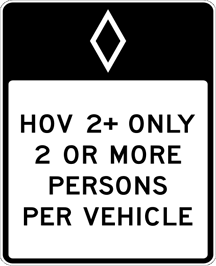 |
HOV RESTRICTED LANE SIGN (R3-10) (a) Justification. The HOV Restricted Lane Sign (R3-10) may be used in advance of a section of roadway wherein travel over a specific lane of the roadway is restricted to provide preferential treatment for certain high occupancy vehicles, to clarity the meaning of the restriction. (b) Placement. When used, the R3-10 sign shall be post-mounted adjacent to the pending restricted lane. (c) Size. When used on an expressway, the standard size of the sign shall be 36 inches x 60 inches, and when used on a freeway, the standard size of the sign shall be 78 inches x 96 inches. |
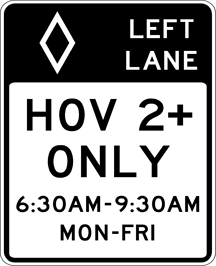 |
HOV PREFERENTIAL LANE SIGN (R3-11A) (a) Justification. The HOV Preferential Lane Sign (R3-11A) may be used adjacent to a section wherein travel over a specific lane of the roadway is restricted to provide preferential treatment for certain high occupancy vehicles. The top line may specify the LEFT LANE as illustrated, or RIGHT LANE, RIGHT 2 LANES, THIS LANE, or similar messages. If another message is not applicable, the symbol may also be centered. Other messages on the sign may vary as necessary. (b) Placement. When used, the R3-11A sign shall be post-mounted adjacent to the restricted lane. (c) Size. When used on an expressway, the standard size of the sign shall be 36 inches x 60 inches, and when used on a freeway, the standard size of the sign shall be 78 inches x 96 inches. |
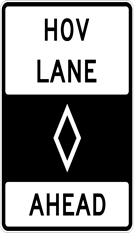 |
HOV PREFERENTIAL LANE AHEAD SIGN (R3-12) (a) Justification. The HOV Preferential Lane Ahead Sign (R3-12) may be used in advance of a section of roadway where travel over a specific lane of the roadway is restricted to provide preferential treatment for certain high occupancy vehicles. (b) Placement. When used, the R3-12 sign shall be post-mounted in advance of the restriction but adjacent to the lane that will be restricted. (c) Size. When used on an expressway, the standard size of the sign shall be 36 inches x 60 inches, and when used on a freeway, the standard size of the sign shall be 48 inches x 84 inches. |
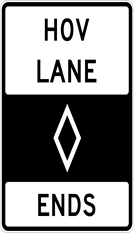 |
HOV PREFERENTIAL LANE ENDS SIGN (R3-12A) (a) Justification. The HOV Preferential Lane Ends Sign (R3-12A) may be used at the end of a section of roadway where travel over a specific lane of the roadway is restricted to provide preferential treatment for certain high occupancy vehicles. (b) Placement. When used, the R3-12A sign shall be post-mounted adjacent to the lane where the restriction ended. (c) Size. When used on an expressway, the standard size of the sign shall be 36 inches x 60 inches, and when used on a freeway, the standard size of the sign shall be 48 inches x 84 inches. |
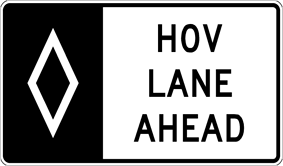 |
HOV PREFERENTIAL LANE AHEAD OVERHEAD SIGN (R3-15) (a) Justification. The HOV Preferential Lane Ahead Overhead Sign (R3-15) shall be authorized for use in advance of a section of roadway wherein travel over a specific lane of the roadway is restricted to specified high occupancy vehicles. (b) Placement. The R3-15 sign shall be mounted overhead an adequate distance in advance of the restricted lane to allow provision for safe movement to and from the restricted lane prior to the actual restriction. (c) Size. The standard size for the R3-15 sign shall be 66 inches x 36 inches. The standard size shall be 84 inches x 48 inches for expressways and 102 inches x 60 inches for freeways. |
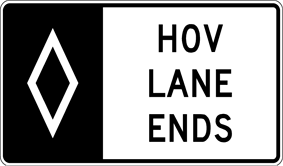 |
HOV PREFERENTIAL LANE ENDS OVERHEAD SIGN (R3-15B) (a) Justification. The HOV Preferential Lane Ends Overhead Sign (R3-15B) shall be authorized for use to indicate the end of a section of roadway over which a lane has been restricted to provide preferential treatment for certain high occupancy vehicles. (b) Placement. The R3-15B sign shall be mounted overhead to mark the end of a section of roadway which has a lane restricted for the preferential use of a certain class or classes of vehicles. (c) Size. The standard size for the R3-15 sign shall be 66 inches x 36 inches. The standard size shall be 84 inches x 48 inches for expressways and 102 inches x 60 inches for freeways. |
 |
BIKE LANE SIGN (R3-17) The Bike Lane Sign (R3-17) should be used at periodic intervals along a designated bicycle lane which is marked with the Bicycle With Rider Symbol pavement marking to call attention to the lane and to the possible presence of bicyclists. |
 |
BEGIN LEFT TURN LANE SIGN (R3-20L) The Begin Left Turn Lane Sign (R3-20L) may be post-mounted on a median (or on the left-hand side of the roadway for a one-way street) at the upstream end of the turn lane taper of a mandatory left-turn lane. |
 |
BEGIN RIGHT TURN LANE SIGN (R3-20R) The Begin Right Turn Lane Sign (R3-20R) may be post-mounted on the right-hand side of the roadway at the upstream end of the turn lane taper of a mandatory left-turn lane. |
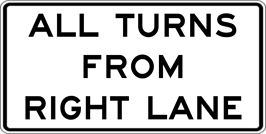 |
ALL TURNS FROM RIGHT LANE SIGN (R3-23) The All Turns From Right Lane Sign (R3-23) may be used on those multi-lane highways where left turns and U-turns are prohibited but when these movements can be indirectly accomplished by making a right turn. The R3-23 sign shall be placed at intervals throughout the section of highway where left turns and U-turns are prohibited and in advance of all right-hand off-ramps where left turns and U-turns can be indirectly accomplished by making a right turn. The standard size of the R3-23 sign shall be 96 inches x 48 inches. The 60 inches x 48 inches size may be used where there is insufficient lateral space to erect the larger size. |
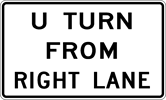 |
U TURN FROM RIGHT LANE SIGN (R3-23A) The U Turn From Right Lane Sign (R3-23A) shall be used on those multi-lane highways where U-turns are prohibited but when these movements can be indirectly accomplished by making a right turn. The R3-23A sign shall be placed at intervals throughout the section of highway where U-turns are prohibited and in advance of all right-hand off-ramps where U-turns can be indirectly accomplished by making a right turn. |
 |
ALL TURNS (45 DEGREE ARROW) SIGN (R3-24) (a) The All Turns (45 Degree Arrow) Sign (R3-24) shall be authorized to indicate the location of a right-hand off-ramp where left turns and U-turns may be indirectly accomplished by making a right-turn. Street or road names, or traffic route numbers may be included directly above this sign message. (b) The R3-24 sign shall be placed in the gore of the off-ramp. |
 |
U AND LEFT TURNS (45 DEGREE ARROW) SIGN (R3-24A) (a) The U and Left Turns (45 Degree Arrow) Sign (R3-24A) shall be authorized to indicate the location of a right-hand off-ramp where left turns and U-turns may be indirectly accomplished by making a right-turn. Street or road names, or traffic route numbers may be included directly above this sign message. (b) The R3-24A sign shall be placed in the gore of the off-ramp. If used with a conventional guide sign, the R3-24A sign shall be mounted below the guide sign. |
 |
U TURN (45 DEGREE ARROW) SIGN (R3-24B) (a) The U Turn (45 Degree Arrow) Sign (R3-24B) shall be authorized to indicate the location of a right-hand off-ramp where U-turns may be indirectly accomplished by making a right-turn. Street or road names, or traffic route numbers may be included directly above this sign message. (b) The R3-24B sign shall be placed in the gore of the off-ramp. If used with a conventional guide sign, the R3-24B sign shall be mounted below the guide sign. |
 |
ALL TURNS (RIGHT ARROW) SIGN (R3-25) (a) The All Turns (Right Arrow) Sign (R3-25) shall be authorized to indicate the location of an intersection where left turns and U-turns may be indirectly accomplished by making a right-turn. Street or road names, or traffic route numbers may be included directly above this sign message. (b) The R3-25 sign shall be placed on the right-hand side of the roadway at the entrance to the jughandle. If used with a conventional guide sign, the R3-25 sign shall be mounted below the guide sign. |
 |
U AND LEFT TURNS (RIGHT ARROW) SIGN (R3-25A) (a) The U and Left Turns (Right Arrow) Sign (R3-25A) shall be authorized to indicate the location of an intersection where left turns and U-turns may be indirectly accomplished by making a right-turn. Street or road names, or traffic route numbers may be included directly above this sign message. (b) The R3-25A sign shall be placed on the right-hand side of the roadway at the entrance to the jughandle. If used with a conventional guide sign, the R3-25A sign shall be mounted below the guide sign. |
 |
U TURN (RIGHT ARROW) SIGN (R3-25B) (a) The U Turn (Right Arrow) Sign (R3-25B) shall be authorized to indicate the location of an intersection where U-turns may be indirectly accomplished by making a right-turn. Street or road names, or traffic route numbers may be included directly above this sign message. (b) The R3-25B sign shall be placed on the right-hand side of the roadway at the entrance to the jughandle. If used with a guide sign, the R3-25B sign shall be mounted below the guide sign. |
 |
U AND LEFT TURNS (STRAIGHT ARROW) SIGN (R3-26) (a) The U and Left Turns (Straight Arrow) Sign (R3-26) shall be authorized to indicate the location where left turns and U-turns may be indirectly accomplished by making a right-turn downstream of the location where the turn would normally have been made. Street or road names, or traffic route numbers may be included directly above this sign message. (b) The R3-26 sign shall be placed on the right-hand side of the roadway at the intersection to inform road users that they need to proceed straight through the intersection in order to make a left turn or U-Turn. If used with a conventional guide sign, the R3-26 sign shall be mounted below the guide sign. |
 |
U TURN (STRAIGHT ARROW) SIGN (R3-26A) (a) The U Turn (Straight Arrow) Sign (R3-26A) shall be authorized to indicate the location where U-turns may be indirectly accomplished by making a right-turn downstream of the location where the turn would normally have been made. (b) The R3-26A sign shall be placed on the right-hand side of the roadway at the intersection to inform road users that they need to proceed straight through the intersection in order to make a U-Turn. If used with a conventional guide sign, the R3-26A sign shall be mounted below the guide sign. |
 |
EXCEPT BUSES PLAQUE (R3-101P) The Except Buses Plaque (R3-101P) may be used below a sign such as, but limited to, the No Right Turn Sign (R3-1), No Left Turn Sign (R3-2), No Turns Sign (R3-3), etc., to exempt buses from a restriction. The width of the R3-101P plaque should always be the same width as the sign in supplements. |
 |
TRUCKS OVER (__) FEET LONG PLAQUE (R3-102P) The Trucks Over (__) Feet Long Plaque (R3-102P) may be used to supplement turn restrictions or other restrictions which apply only to tucks over a designated length. The designated length should be determined by an engineering study. |
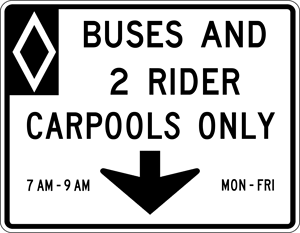 |
PREFERENTIAL LANE SIGN (R3-103) (a) Justification. The Preferential Lane Sign (R3-103) shall be authorized for use at the beginning of, and at frequent intervals within, a section of roadway where travel over a specific lane of the roadway is restricted to a specific class or classes of vehicles in accordance with Department of Transportation regulations (relating to preferential lane-use control signs). (b) Format. The message of the R3-103 sign should have the following sequence:
(c) Placement. The R3-103 sign shall be mounted directly over a preferential lane at frequent intervals. The spacing of such signs shall be based on engineering judgment taking into account prevailing speeds, block lengths, distance from intersections or interchanges, and other considerations necessary to adequately communicate with the driver. (d) Size. The standard size of the R3-103 sign shall be 72 inches x 60 inches. The standard size shall be 96 inches x 72 inches for expressways and 108 inches x 84 inches for freeways. |
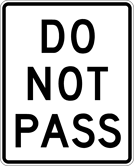 |
DO NOT PASS SIGN (R4-1) The Do Not Pass Sign (R4-1) is authorized for use at the beginning of and at intervals within a no passing zone established in accordance with Department of Transportation regulations. However, when a no passing zone on a two-lane roadway begins at other than an intersection, the No Passing Zone Sign (W14-3) should be installed at beginning of the zone when space exists instead of the R4-l sign. Requirements for placement shall be as follows:
The standard size R4-1 sign shall be 24 inches x 30 inches. The standard size for expressways shall be 36 inches x 48 inches. |
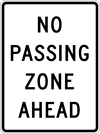 |
NO PASSING ZONE AHEAD SIGN (R4-1A) The No Passing Zone Ahead Sign (R4-lA) may be used on multi-lane, two-way highways in advance of the initial Do Not Pass Sign (R4-1) in each no passing zone when it is not possible to install a No Passing Zone Sign (W14-3) in the median. When used, the R4-1A sign should be placed approximately 500 feet to 1000 feet in advance of the R4-1 sign. |
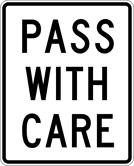 |
PASS WITH CARE SIGN (R4-2) The Pass With Care Sign (R4-2) shall be used to identify the end of a no-passing zone and to indicate that passing is permitted. The R4-2 sign should normally be installed on the right side of the road at the location where the no passing zone ends and the passing zone begins. When the passing zone begins at an intersection, the R4-2 sign should be installed within 500 feet after the intersection. The standard size of the R4-2 sign shall be 24 inches x 30 inches. The standard size for expressways shall be 36 inches x 48 inches. |
 |
RIGHT TURN LANE/BIKES SIGN (R4-4) The Right Turn Lane/Bikes Sign (R4-4) may be used on highways where available lateral clearances make it likely that bicyclists with either travel on the roadway or on the shoulder but in close proximity to the roadway. It should be used in areas where a right vehicular turning lane will cross over either a marked bicycle lane or a shoulder area where there is a high likelihood of bicycle travel. Other uses may include intersections with a documented car-bike crash history and a road being promoted as a cycling route. The R4-4 sign should be located at the beginning of the right turn lane. |
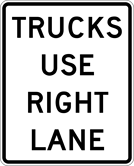 |
TRUCKS USE RIGHT LANE SIGN (R4-5) The Trucks Use Right Lane Sign (R4-5) may be used on multi-lane roadways when an extra or "climbing" lane has been provided on an upgrade for commercial motor vehicles, or truck tractors and trailers or semitrailers. When used, a Truck Lane (__) Feet Sign (R4-6) should be erected in advance of the climbing lane and a series of Pavement Width Transition Signs should be erected in advance of the termination of the extra lane. The R4-5 sign may be erected alone or in a series with other signs, and shall be placed at reasonable intervals. The standard size of the R4-5 sign shall be 24 inches x 30 inches. The standard size for expressways shall be 36 inches x 48 inches. |
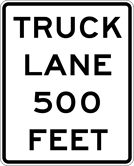 |
TRUCK LANE (__) FEET SIGN (R4-6) The Truck Lane (__) Feet Sign (R4-6) may be used in advance of the beginning of the extra or "climbing" lane which has been provided for commercial vehicles or truck tractors and trailers or semi-trailers. The standard size of the R4-6 shall be 24 inches x 30 inches. The standard size for expressways shall be 36 inches x 48 inches. |
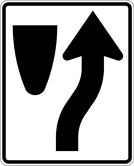 |
KEEP RIGHT SIGN (R4-7) The Keep Right Sign (R4-7) may be used at the ends of medians, parkways, loading islands, and refuge islands, at traffic islands and at underpass piers, where traffic is required to keep to the right of such obstructions. The R4-7 sign may not always be necessary at intermediate ends of divisional islands and medians and should not be used with other signs that obviously mark locations where motorists know they must pass on the right. The standard size of the R4-7 sign is 24 inches x 30 inches, except on expressways the standard size is 36 inches x 48 inches. It may also be desirable to install a Object Marker (OM1-3) on the same sign post with the top of the marker at an appropriate 4 feet height. |
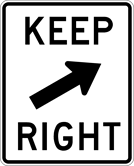 |
KEEP RIGHT WITH 30 DEGREE ARROW SIGN (R4-7B) The Keep Right With 30 Degree Arrow Sign (R4-7B) may be used at the ends of medians, parkways, loading islands, and refuge islands, at traffic islands and at underpass piers, where traffic is required to keep to the right of such obstructions. The R4-7B sign may not always be necessary at intermediate ends of divisional islands and medians and should not be used with other signs that obviously mark locations where motorists know they must pass on the right. The standard size of the R4-7B sign is 24 inches x 30 inches except on expressways the standard size is 36 inches x 48 inches. It may also be desirable to install a Object Marker (OM1-3) on the same sign post with the top of the marker at an approximate 4 feet height. |
 |
KEEP RIGHT (NARROW) SIGN (R4-7C) The Keep Right (Narrow) Sign (R4-7C) may be used at the ends of medians, parkways, loading islands, and refuge islands, at traffic islands and at underpass piers, where traffic is required to keep to the right of such obstructions, and where the island is less than 4 feet wide at the point where the sign is to be located. The R4-7C sign may not always be necessary at intermediate ends of divisional islands and medians and should not be used with other signs that obviously mark locations where motorists know they must pass on the right. |
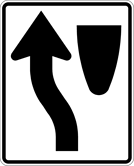 |
KEEP LEFT SIGN (R4-8) The Keep Left Sign (R4-8) may be used at the ends of medians, parkways, loading islands, and refuge islands, at traffic islands and at underpass piers, where traffic is required to keep to the left of such obstructions. The R4-8 sign may not always be necessary at intermediate ends of divisional islands and medians and should not be used with other signs that obviously mark locations where motorists know they must pass on the left. The standard size of the R4-8 sign is 24 inches x 30 inches, except on expressways the standard size is 36 inches x 48 inches. It may also be desirable to install a Object Marker (OM1-3) on the same sign post with the top of the marker at an appropriate 4 feet height. |
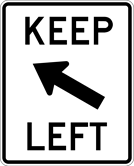 |
KEEP LEFT WITH 30 DEGREE ARROW SIGN (R4-8B) The Keep Left With 30 Degree Arrow Sign (R4-8B) may be used at the ends of medians, parkways, loading islands, and refuge islands, at traffic islands and at underpass piers, where traffic is required to keep to the left of such obstructions. The R4-8B sign may not always be necessary at intermediate ends of divisional islands and medians and should not be used with other signs that obviously mark locations where motorists know they must pass on the left. The standard size of the R4-8B sign is 24 inches x 30 inches except on expressways the standard size is 36 inches x 48 inches. It may also be desirable to install a Object Marker (OM1-3) on the same sign post with the top of the marker at an approximate 4 feet height. |
 |
KEEP LEFT (NARROW) SIGN (R4-8C) The Keep Left (Narrow) Sign (R4-8C) may be used at the ends of medians, parkways, loading islands, and refuge islands, at traffic islands and at underpass piers, where traffic is required to keep to the left of such obstructions, and where the island is less than 4 feet wide at the point where the sign is to be located. The R4-8C sign may not always be necessary at intermediate ends of divisional islands and medians and should not be used with other signs that obviously mark locations where motorists know they must pass on the left. |
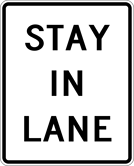 |
STAY IN LANE SIGN (R4-9) The Stay In Lane Sign (R4-9) may be used on a multi-lane conventional highway to prohibit lane changing, or may be used on single lane conventional highways at horizontal curves to prohibit vehicles crossing the centerline when traveling around the curve. |
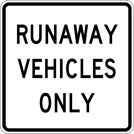 |
RUNAWAY VEHICLES ONLY SIGN (R4-10) (a) Justification. The Runaway Vehicles Sign (R4-10) is authorized for use on runaway truck ramps to prohibit vehicles other than runaway vehicles from using the ramp. The Advance Runaway Truck Ramp Sign (W7-4) and the Runaway Truck Ramp Exit Sign (W7-4B) should also be used to provide advance warning of the ramp. (b) Placement. The R4-10 sign shall be placed near the entrance of the ramp. The sign should be placed on the right side of the ramp and set at an angle of approximately 45 degrees with a line parallel to the edge of the ramp. |
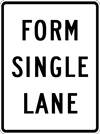 |
FORM SINGLE LANE SIGN (R4-10-1) The Form Single Lane Sign (R4-10-1) may be used when two or more travel lanes are required to merge into a single travel lane. |
 |
BICYCLES MAY USE FULL LANE SIGN (R4-11) The Bicycles May Use Full Lane Sign (R4-11) may be used on roadways where no bicycle lanes or adjacent shoulders usable by bicyclists are present and where travel lanes are too narrow for bicyclists and motor vehicles to operate side by side. The R4-11 sign may be used in locations where it is important to inform road users that bicyclists might occupy the travel lane. |
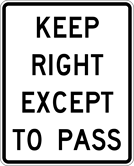 |
KEEP RIGHT EXCEPT TO PASS SIGN (R4-16) The Keep Right Except To Pass Sign (R4-16) may be used on multi-lane conventional highways to direct drivers to stay in the right-hand lane except when they are passing another vehicle. If used, the R4-16 sign should be installed just beyond the beginning of a multi-lane conventional highway and at selected locations along multi-lane conventional highways for additional emphasis. |
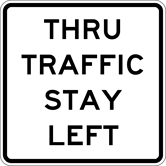 |
THRU TRAFFIC STAY LEFT SIGN (R4-20) The Thru Traffic Stay Left Sign (R4-20) may be used in advance of a right-hand exit which is followed by a right lane drop. The word "RIGHT" may be substituted for the word "LEFT" for a left-hand exit which is followed by a left lane drop. |
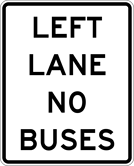 |
LEFT LANE NO BUSES SIGN (R4-101) The Left Lane No Buses Sign (R4-101) may be used to exclude buses from certain travel lanes on multi-lane conventional highways. The R4-101 sign may be erected in a series with other signs, and shall be placed at reasonable intervals. |
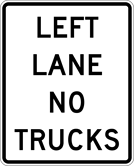 |
LEFT LANE NO TRUCKS SIGN (R4-102) The Left Lane No Trucks Sign (R4-102) may be used to exclude trucks from certain travel lanes on multi-lane conventional highways. The R4-102 sign may be erected in a series with other signs, and shall be placed at reasonable intervals. |
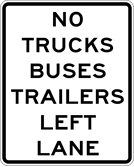 |
NO TRUCKS BUSES TRAILERS LEFT LANE SIGN (R4-103) The No Trucks Buses Trailers Left Lane Sign (R4-103) may be used where particular types of vehicles are prohibited from using specific lanes. Such restrictions generally have limited application, such as on some high-volume freeways with three-lanes or wider roadways, where excluding large or less maneuverable vehicles from the left may improve traffic flow. The R4-103 sign shall be placed at, or near, the beginning of the restriction. Additional signs should be placed within the restricted section, at intervals generally exceeding 1.25 miles. Where the restriction applies to the left lane of a one-way roadway, the signs should be placed on the left side of the roadway. |
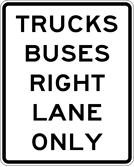 |
TRUCKS BUSES RIGHT LANE ONLY SIGN (R4-104) The Trucks Buses Right Lane Only Sign (R4-104) may be used to exclude trucks and buses from certain travel lanes on multi-lane conventional highways in accordance with Department of Transportation regulations or in construction zones to keep trucks and buses off lanes that are not designed or constructed to carry these higher loads. The R4-104 sign, when used, may be erected alone or in a series with other signs, and shall be placed at reasonable intervals. The word "LEFT" may be substituted for the word "RIGHT" where applicable. |
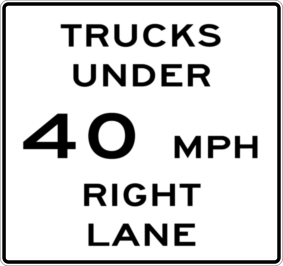 |
TRUCK MINIMUM SPEED LIMIT SIGN (R4-105) (a) Justification. The Truck Minimum Speed Limit Sign (R4-105) may be used on grades when slow moving trucks in the left lane impedes the normal flow of traffic. (b) Placement. The R4-105 sign may be erected alone or in a series with other signs and shall be placed at reasonable intervals. |
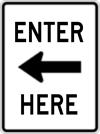 |
ENTER HERE SIGN (R4-106) The Enter Here Sign (R4-106) is authorized for use at ramp entrances, at intersections, channelized intersections and driveways where the entrance and exit roadways are adjacent to each other and left-turning traffic may enter the exit lane by mistake. The sign shall be erected on the far side of the ramp, intersection, or driveway. The standard size R4-106 sign is 24 inches x 30 inches. The 36 inches x 48 inches size may be used where emphasis is needed. |
 |
KEEP OFF SHOULDER SIGN (R4-107) (a) Justification. The Keep Off Shoulder Sign (R4-107) may be used to prohibit traffic from using a shoulder when such usage creates a safety problem or damages the shoulder. (b) Placement. When used, the R4-107 should be installed along the shoulder in the vicinity of the problem location. |
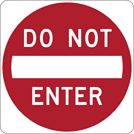 |
DO NOT ENTER SIGN (R5-1) (a) Justification. The Do Not Enter Sign (R5-1) shall be authorized for use to prohibit traffic from entering a restricted road section. (b) Placement. The R5-1 sign should normally be mounted on the right-hand side of the roadway, facing traffic entering the roadway or ramp in the wrong direction. However, a second sign on the left-hand side of the roadway may be justified, particularly where traffic may be approaching in a turn. (c) Size. The standard size of the R5-1 sign shall be 30 inches x 30 inches for single lane conventional highways, 36 inches x 36 inches for multi-lane conventional highways and expressways, and 48 inches x 48 inches for freeways. |
 |
WRONG WAY SIGN (R5-1A) The Wrong Way (R5-1A) may be used as a supplement to the Do Not Enter Sign (R5-1) when an exit ramp intersects a crossroad or a crossroad intersects a divided highway in a manner that may invite wrong-way entry. The R5-1A sign should be placed at a location along the exit ramp or the divided roadway farther from the intersection than the Do Not Enter sign. The standard size of the R5-1A shall be 36 inches x 24 inches for single lane conventional highways and 48 inches x 30 inches for multi-lane conventional highways and freeways. |
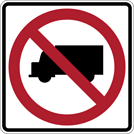 |
NO TRUCK SIGN (R5-2) (a) Justification. The No Truck Sign (R5-2) shall be authorized for use to prohibit trucks, except that such vehicles may be operated for the purpose of delivering or picking up materials or merchandise. When local truck deliveries are permitted, the Except Local Deliveries Sign (R5-2-3) shall be mounted beneath the R5-2 sign. (b) Size. The standard size of the R5-2 sign shall be 24 inches x 24 inches. |
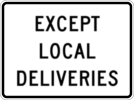 |
EXCEPT LOCAL DELIVERIES SIGN (R5-2-3) The Except Local Deliveries Sign (R5-2-3) may be used below the No Trucks Sign (R5-2), Weight Limit (__) Tons Sign (R12-1), and the Except Combinations (__) Tons Sign (R12-5A) when kinds of classes of vehicles are prohibited except for local deliveries. Local deliveries are defined as deliveries going to or from a residence, commercial establishment, or farm located on a posted highway or which can be reached only via a posted highway. The R5-2-3 sign shall not, however, be used when a bridge or other structure is not capable of supporting the legal weight limit. The term "RESIDENTIAL" may be substituted for "LOCAL" if there is a commercial development in the area and satisfactory alternate roadways exist for the commercial development. When used, the R5-2-3 sign shall be mounted below the R5-2, R12-1, or R12-5A sign. The R5-2-3 sign shall be the same width as the sign it supplements. |
| TRUCK WEIGHT (LENGTH) RESTRICTION PANEL (R5-2-4) (a) Justification. The Truck Weight (Length) Restriction Panel (R5-2-4) shall be authorized for use in conjunction with the No Trucks Sign (R5-2) when it has been determined in accordance with engineering and traffic studies, that the length or weight of trucks prohibited should be defined. (b) Placement. The R5-2-4 sign, when used, shall be mounted below the No Trucks Sign (R5-2). |
 |
EXCEPT LOCAL TRAFFIC SIGN (R5-2-5) The Except Local Sign (R5-2-5) may be used in conjunction with a regulatory or detour sign when it is desirable to influence through traffic from entering a specific area. |
 |
NO MOTOR VEHICLES SIGN (R5-3) (a) Justification. The No Motor Vehicles Sign (R5-3) may be used where motor vehicles are prohibited from using a bicycle trail or other facility. (b) Placement. The R5-3 sign should be placed at the entrance points to the bicycle trail or at any other necessary location. |
 |
MOTOR VEHICLES ONLY SIGN (R5-3-1) (a) Justification. The Motor Vehicles Only Sign (R5-3-l) shall be authorized for use where the Secretary, by resolution or ruling or State Law prohibits pedestrians, bicycles and all other than motorized vehicular traffic from freeways and expressways. (b) Placement. The R5-3-1 sign should be placed on entrance ramps or elsewhere where access is available. |
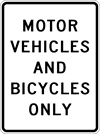 |
MOTOR VEHICLES AND BICYCLES ONLY SIGN (R5-3-1A) The Motor Vehicles and Bicycles Only Sign (R5-3-1A) shall be used at all freeway entrance ramps for those sections of freeway where bicycles as well as motor vehicles are permitted. It should be placed at the beginning of the ramp where bicyclists and motorists can see it and before motorists are involved with the actual merge movement onto the freeway proper. The Bicycle Restrictions Sign (R5-3-1D) shall be mounted below the R5-3-1A sign. |
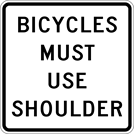 |
BICYCLES MUST USE SHOULDER SIGN (R5-3-1B) The Bicycles Must Use Shoulder Sign (R5-3-1B) shall be used to direct bicyclists to the proper position on the highway and alert motorists to the presence of bicyclists on the freeway. The R5-3-1B sign shall be used on freeway segments where bicyclists are permitted. They shall be placed along the roadway so they can be viewed by both bicyclists and motorists. |
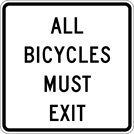 |
ALL BICYCLES MUST EXIT SIGN (R5-3-1C) The All Bicycles Must Exit Sign (R5-3-1C) shall be used at freeway interchange exit ramps beyond which bicycles are not permitted. |
 |
BICYCLE RESTRICTIONS SIGN (R5-3-1D) The Bicycle Restrictions Sign (R5-3-1D) shall indicate the age restrictions for bicyclists on freeways. The R5-3-1D sign shall be mounted below the Motor Vehicles and Bicycles Only Sign (R5-3-1A). |
| PEDESTRIANS ONLY SIGN (R5-3-2) (a) Justification. The Pedestrians Only Sign (R5-3-2) may be used where vehicles are prohibited from using a sidewalk, walkway, or section of highway. (b) Placement. The R5-3-2 sign shall be erected at the beginning of the facility that vehicles are prohibited from, and shall be oriented to be visible by approaching traffic. |
 |
NO TRUCKS OR BUSES SIGN (R5-3-4) (a) Justification. The No Trucks or Buses Sign (R5-3-4) shall be authorized to prohibit trucks and buses from using a roadway or a structure. (b) Placement. The R5-3-4 sign shall be erected immediately in advance of the of the beginning of the restricted area. In addition, the sign shall be erected at the last intersection along with a Distance Ahead Plaque (W16-103P) indicating the distance to the beginning of the restriction in order to allow restricted vehicles to use an alternate route. |
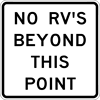 |
NO RV'S BEYOND THIS POINT SIGN (R5-3-5) The No RV's Beyond This Point Sign (R5-3-5) may be used to prohibit recreational vehicles from using a roadway or structure in accordance with an engineering and traffic study. The R5-3-5 sign should be erected immediately in advance of the beginning of the restricted area. In addition, the sign should be placed in a location to allow vehicles to use an alternate route or perform a U-turn. |
 |
NO BICYCLES SIGN (R5-6) (a) Justification. The No Bicycles Sign (R5-6) shall be authorized for use where it has been determined by the Department of Transportation or local authorities by ordinance, resolution, or ruling that bicycles shall be prohibited. (b) Placement. The R5-6 sign shall be placed at each end of the restricted section of highway and at all intersections within the restricted section. (c) Size. The standard size of the R5-6 sign shall be 24 inches x 24 inches. |
| NO PEDESTRIANS SIGN (R5-10C) (a) Justification. The No Pedestrians Sign (R5-10C) may be used where pedestrians are prohibited from using the highway or other facility. (b) Placement. The R5-10C sign should be placed at the entrance points to the highway or at any other necessary location. |
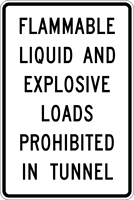 |
FLAMMABLE LIQUID AND EXPLOSIVE LOADS PROHIBITED IN TUNNEL SIGN (R5-20) (a) Justification. The Flammable Liquid And Explosive Loads Prohibited In Tunnel Sign (R5-20) shall be authorized for use when vehicles carrying flammable liquid or explosive loads are prohibited within a tunnel. (b) Placement. The R5-20 sign shall be placed in advance of the tunnel entrance. |
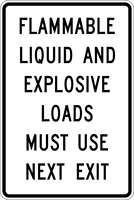 |
FLAMMABLE LIQUID AND EXPLOSIVE LOADS MUST USE NEXT EXIT SIGN (R5-20-1) (a) Justification. The Flammable Liquid And Explosive Loads Must Use Next Exit Sign (R5-20-1) shall be authorized for use in advance of a designated section of limited access highway where vehicles carrying flammable liquid or explosive loads are prohibited. It shall be used in conjunction with the Flammable Liquid and Explosive Loads Prohibited In Tunnel Sign (R5-20). (b) Placement. The R5-20-1 sign shall be in advance of the last exit prior to entering the section of highway where said vehicles are prohibited. Care should be taken in selecting the exit to assure there are no restrictions affecting the vehicles that must use it. |
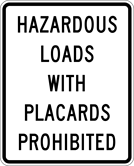 |
HAZARDOUS LOADS WITH PLACARDS PROHIBITED SIGN (R5-21) The Hazardous Loads With Placards Prohibited Sign (R5-21) may be used to prohibit placarded hazardous materials from a section of roadway. |
 |
HAZARDOUS MATERIALS MUST FOLLOW DETOUR SIGN (R5-21-1) The Hazardous Materials Must Follow Detour Sign (R5-21-1) may be used to prohibit materials from a section of roadway and to require the vehicles to follow a detour route. |
 |
EMERGENCY AND AUTHORIZED VEHICLES ONLY SIGN (R5-101) The Emergency and Authorized Only Sign (R5-101) shall be authorized for use to mark median crossovers for the use indicated on freeways and expressways. This sign should be placed on the far side of the crossover. |
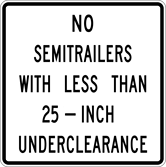 |
SEMITRAILER MINIMUM UNDERCLEARANCE SIGN (R5-102) (a) Justification. The Semitrailer Minimum Underclearance Sign (R5-102) shall be authorized when it has been determined that it is necessary to prohibit semitrailers with an underclearance less than a specified dimension. This restriction would be applicable on crest vertical curves, especially over a railroad grade crossing. (b) Placement. The R5-102 sign should be located immediately in advance of the section of highway to which it applies. In the case of an extended distance between the restriction and the nearest intersection, a second sign should be placed not more than 25 feet beyond the intersection so as to be clearly visible from all vehicles about to enter the highway with the restriction. |
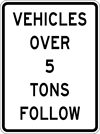 |
VEHICLES OVER (__) (__) FOLLOW SIGN (R5-103) The Vehicles Over (__) (__) Follow Sign (R5-103) may be used to establish an alternate route for vehicles that exceed a specific vertical length or weight restriction along a highway. When used, a Red Arrow Sign (G20-6-1) shall be mounted below the R5-103 sign and along the alternate route for routing purposes. Additional colors may be used for the arrow sign. |
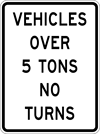 |
VEHICLES OVER (__) TONS NO TURNS SIGN (R5-104) The Vehicles Over (__) Tons No Turns Sign (R5-104) may be used to prohibit vehicles over a designated weight from turning into an intersecting street. The R5-104 sign, when used, shall be placed in advance of the intersection and near right and far left at the intersecting, except at a T-intersection where a right turn only is prohibited, the far left sign is not required. |
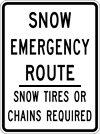 |
SNOW EMERGENCY ROUTE SIGN (R5-105) The Snow Emergency Route Sign (R5-105) may be used at the entrances to limited access highways which have officially been designated as snow emergency routes in accordance with Department of Transportation regulations. |
 |
HORIZONTAL LEFT ONE-WAY SIGN (R6-1L) (a) Justification. The Horizontal Left One-Way Sign (R6-1L) shall be authorized for use to indicate a street, roadway, or alley upon which vehicular traffic is permitted to travel in only one direction. (b) Placement. At unsignalized intersections, the R6-1L sign shall be placed on the near right-hand and the far side of the intersection so as to face traffic entering or crossing the one-way street. At signalized intersections, the R6-1L sign shall be placed either near the appropriate signal faces, on poles holding the traffic signals, on mast arm or span wire holding the signals, or at the locations specified for unsignalized intersections. (c) Size. The standard size of the R6-1L sign for single lane conventional shall be 36 inches x 12 inches. The standard size for multi-lane conventional highways and expressways shall be 54 inches x 18 inches. |
 |
HORIZONTAL RIGHT ONE- WAY SIGN (R6-1R) (a) Justification. The Horizontal Right One-Way Sign (R6-1R) shall be authorized for use to indicate a street, roadway, or alley upon which vehicular traffic is permitted to travel in only one direction. Where the central island of a roundabout allows for installation of signs, the R6-1R sign may be used instead of or in addition to Roundabout Directional Arrow (R6-4 series) signs to direct traffic counter-clockwise around the central island. (b) Placement. At unsignalized intersections, the R6-1R sign shall be placed on the near right-hand and the far side of the intersection so as to face traffic entering or crossing the one-way street. At signalized intersections, the R6-1R sign shall be placed either near the appropriate signal faces, on poles holding the traffic signals, on mast arm or span wire holding the signals, or at the locations specified for unsignalized intersections. Where used on the central island of a roundabout, the mounting height of a R6-1R sign should be at least 4 feet, measured vertically from the bottom of the sign to the elevation of the near edge of the traveled way. (c) Size. The standard size of the R6-1R sign for single lane conventional highways shall be 36 inches x 12 inches. The standard size for multi-lane conventional highways and expressways shall be 54 inches x 18 inches. |
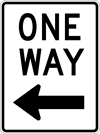 |
VERTICAL LEFT ONE-WAY SIGN (R6-2L) (a) Justification. The Vertical Left One-Way Sign (R6-2L) shall be authorized for use only when lateral space is limited, in lieu of the Horizontal Left One-Way Sign (R6-1L). (b) Size. The standard size of the R6-2L sign for single lane conventional highways shall be 24 inches x 30 inches for post-mounted signs. The standard size for overhead installations and multi-lane highways shall be 30 inches x 36 inches. |
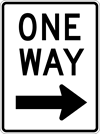 |
VERTICAL RIGHT ONE-WAY SIGN (R6-2R) (a) Justification. The Vertical Right One-Way Sign (R6-2R) shall be authorized for use only when lateral space is limited, in lieu of the Horizontal Right One-Way Sign (R6-1R) and for overhead installations. Where the central island of a roundabout allows for installation of signs, the R6-2R sign may be used instead of or in addition to the Roundabout Directional Arrow (R6-4 series) signs to direct traffic counter-clockwise around the central island. (b) Size. The standard size of the R6-2R sign for single lane conventional highways shall be 24 inches x 30 inches for post-mounted signs. The standard size for overhead installations and multi-lane highways shall be 30 inches x 36 inches. (c) Placement. When used on the central island of a roundabout, the mounting height of a R6-2R sign should be at least 4 feet, measured vertically from the bottom of the sign to the elevation of the near edge of the traveled way. |
 |
DIVIDED HIGHWAY CROSSING SIGN (R6-3) (a) Justification. The Divided Highway Crossing Sign (R6-3) shall be used on unsignalized minor-street approaches from which both left-turns and right-turns are permitted onto a divided highway that has a median width at the intersection of 30 feet or more and a speed limit of 30 MPH or higher. The R6-3 sign may be used on unsignalized and signalized minor-street approaches from which left-turns and right-turns are permitted onto a divided highway to advise road users that they are approaching an intersection with a divided highway. (b) Placement. When used, the R6-3 sign should be placed below the nearside stop or yield sign, or should be mounted separately where traffic control signals are present. |
 |
DIVIDED HIGHWAY SIDEROAD CROSSING SIGN (R6-3A) (a) Justification. The Divided Highway Sideroad Crossing Sign (R6-3A) shall be used on unsignalized minor-street approaches from which both left-turns and right-turns are permitted onto a divided highway that has a median width at the intersection of 30 feet or more and a speed limit of 30 MPH or higher. The R6-3A sign may be used on unsignalized and signalized minor-street approaches from which left-turns and right-turns are permitted onto a divided highway to advise road users that they are approaching an intersection with a divided highway. (b) Placement. When used, the R6-3A sign should be placed below the nearside stop or yield sign, or should be mounted separately where traffic control signals are present. |
 |
ROUNDABOUT DIRECTIONAL (2 CHEVRONS) SIGN (R6-4) (a) Justification. The Roundabout Directional (2 Chevrons) Sign (R6-4) shall be installed on the central island of roundabouts with single lane approaches to indicate the direction of travel within the circulatory roadway. The Horizontal Right One-Way Sign (R6-1R) shall be installed directly above the R6-4 whenever the R6-4 is used. (b) Placement. The R6-4 sign shall be placed on the central island opposite the roundabout entrances. A reduced mounting height of at least 4 feet is permitted. (c) Size. The standard size of the R6-4 sign shall be 24 inches x 30 inches. On multi-lane approaches or whenever special circumstances indicate the need for larger signs, the R6-4A or R6-4B shall be used. |
 |
ROUNDABOUT DIRECTIONAL (3 CHEVRONS) SIGN (R6-4A) (a) Justification. The Roundabout Directional (3 Chevrons) Sign (R6-4A) shall be installed on the central island of roundabouts with multi-lane approaches to indicate the direction of travel within the circulatory roadway. The Horizontal Right One-Way Sign (R6-1R) shall be installed directly above the R6-4A whenever the R6-4A is used. (b) Placement. The R6-4A sign shall be placed on the central island opposite the roundabout entrances. A reduced mounting height of at least 4 feet is permitted. (c) Size. The standard size of the R6-4A sign shall be 48 inches x 24 inches. The R6-4A may be used whenever special circumstances indicate the need for a sign larger than the R6-4. |
 |
ROUNDABOUT DIRECTIONAL (4 CHEVRONS) SIGN (R6-4B) (a) Justification. The Roundabout Directional (4 Chevrons) Sign (R6-4B) shall be installed on the central island of roundabouts with multi-lane approaches to indicate the direction of travel within the circulatory roadway. The Horizontal Right One-Way Sign (R6-1R) shall be installed directly above the R6-4B whenever the R6-4B is used. (b) Placement. The R6-4B sign shall be placed on the central island opposite the roundabout entrances. A reduced mounting height of at least 4 feet is permitted. (c) Size. The standard size of the R6-4A sign shall be 60 inches x 24 inches. The R6-4B may be used whenever special circumstances indicate the need for a sign larger than the R6-4. |
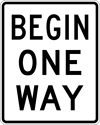 |
BEGIN ONE-WAY SIGN (R6-6) The Begin One-Way Sign (R6-6) may be used when a two-way roadway changes to a one-way roadway. As such, the R6-6 sign advises drivers that they can use the left side of the roadway. The R6-6 sign should be placed on the right side of the one-way roadway near the beginning of the one-way roadway. The standard size R6-6 for single lane conventional highways shall be 24 inches x 30 inches. The standard size for multi-lane conventional highways shall be 30 inches x 36 inches. |
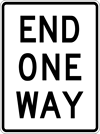 |
END ONE-WAY SIGN (R6-7) The End One-Way Sign (R6-7) may be used when a one-way street or roadway changes to a two-way street or roadway. The R6-7 sign should be placed on both right and left sides of the street or roadway at the approximate point of change to a two-way operation. It should be preceded with a Two-Way Traffic Sign (W6-3). The standard size of the R6-7 sign for single lane conventional highways shall be 24 inches x 30 inches. The standard size for multi-lane conventional highways shall be 30 inches x 36 inches. |
| NO PARKING RESTRICTED HOURS SIGN (R7-2) The No Parking Restricted Hours Sign (R7-2) may be used in lieu of a separate No Parking Symbol Sign (R8-3) and a No Parking Restricted Hours Plaque (R8-3HP-1) to prohibit parking on a roadway during certain hours. |
| NO PARKING RESTRICTED DAYS SIGN (R7-3-1) The No parking Restricted Days Sign (R7-3-1) may be used in lieu of a separate No Parking Symbol Sign (R8-3) and a Restricted Hours Plaque (R10-20AP) to prohibit parking on a roadway during a specific day of the week. |
| NO STANDING ANY TIME SIGN (R7-4) The No Standing Any Time Sign (R7-4) shall be authorized use when the halting of a vehicle is prohibited, except momentarily for the purpose of and while actually engaged in receiving or discharging passengers. |
 |
NO STOPPING OR STANDING SIGN (R7-4A) The No Stopping or Standing Sign (R7-4A) shall be authorized for use when the momentarily halting of a vehicle is prohibited, except when necessary to avoid conflict with traffic or in compliance with the directions of a police officer or traffic-control device. |
| LIMITED TIME PARKING SIGN (R7-5) The Limited Time Parking Sign (R7-5) shall be authorized for use when there is a necessity for limiting the duration of parking. It may be, and is frequently used in conjunction with meter parking. The format of the sign shall include the time limit and hours of effectiveness of the limited time parking. |
| NO PARKING LOADING ZONE SIGN (R7-6-1) The No Parking Loading Zone Sign (R7-6-1) may be used in lieu of a separate No Parking Symbol Sign (R8-3) and a No Parking Restricted Hours Plaque (R8-3HP-1) to prohibit parking when curb space is utilized for loading and unloading commercial vehicles. |
| RESERVED PARKING SIGN (R7-8) The Reserved Parking Sign (R7-8) is authorized to mark the location of a parking space which is reserved for handicapped persons or severely disabled veterans. When used, the R7-8 sign should generally be installed at the front of each reserved parking stall; except in the case of parallel parking, it should be installed at intervals not exceeding 100 feet along the sides of the stalls. When installed at the front of the parking stalls, the single or double headed arrow may be deleted from the R7-8 sign and the message may be spaced accordingly. The Reserved Parking Penalties Sign (R7-8F) shall be posted in conjunction with the R7-8 sign. When used, the R7-8F sign shall be placed below the R7-8 sign. |
| RESERVED PARKING PENALTIES SIGN (R7-8F) The Reserved Parking Penalties Sign (R7-8F) shall be installed with the Reserved Parking Sign (R7-8). When used, the R7-8F sign shall be placed below the R7-8 sign. In order to improve visibility of the signs installed at the front of reserved stalls, a substandard height to the bottom of the sign of approximately 3 feet — 8 inches above the parking stall elevation may be used. |
| VAN ACCESSIBLE SIGN (R7-8P) The Van Accessible Sign (R7-8P) may be a supplemental sign to indicate that a parking space signed with the Reserved Parking Sign (R7-8) is of sufficient size for use by the disabled to accommodate vans displaying a handicapped or severely disabled veteran registration plate or placard. One in every eight reserved parking spaces for the disabled, but not less than one, shall be designated with the R7-8P sign. When used, the R7-8P sign shall be placed immediately below the Reserved Parking Sign (R7-8). |
| RESERVED PARKING — STATE POLICE ONLY SIGN (R7-8-1) The Reserved Parking — State Police Only Sign (R7-8-1) may be to mark the location of a parking space which is reserved for State Police vehicles. Typical uses for the R7-8-1 sign include off-street parking areas and service plazas on the Turnpike. |
| RESERVED PARKING EDUCATIONAL PLAQUE (R7-8-2) (a) Justification. The Reserved Parking Educational Plaque (R7-8-2) may be used as a supplemental sign to indicate that a parking space signed with the Reserved Parking Sign (R7-8) is for use by a vehicle displaying a handicapped or severely disabled veteran registration plate or displaying a handicapped or severely disabled veteran placard. (b) Placement. When used, the sign shall be placed immediately below the Reserved Parking Sign (R7-8). (c) Size. The R7-8-2 sign shall be the same width as the R7-8 sign it supplements. The R7-8-2 may also be made an integral part of the Reserved Parking Sign (R7-8) by increasing the length of the R7-8 sign blank the appropriate dimension. |
| PERMIT PARKING FOR GOVERNOR'S RESIDENCE SIGN (R7-8-3) The Permit Parking For Governor's Residence Sign (R7-8-3) may be used to mark the location of parking which is reserved for people visiting or working at the Governor's residence. Parking permits will be issued for enforcement purposes. For locations restricted to buses, the word "BUS" may replace the word "PERMIT". |
| ONE HOUR PARKING EXCEPT TURNPIKE EMPLOYEES SIGN (R7-9) The One Hour Parking Except Turnpike Employees Sign (R7-9) may be authorized for use at Turnpike toll plazas or other appropriate locations along the Turnpike to restrict non-employee parking to a one hour time limit. |
| TEMPORARY NO PARKING SIGN (R7-10) (a) Justification. The Temporary No Parking Sign (R7-10) shall be authorized for use when local authorities deem it necessary to prohibit parking for a short time on any street or highway. Care shall be taken to see that the signs are removed when their need no longer exists. (b) Placement. Since the use of this sign is temporary, it may be made of cardboard and attached to poles, trees, or other existing supports at convenient heights, angles, and locations. |
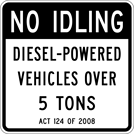 |
NO IDLING SIGN (R7-100) (a) Justification. The No Idling Sign (R7-100) shall be authorized for use to comply with the requirements of Act 124 of 2008 to erect and maintain a permanent sign informing drivers that idling is restricted. (b) Size. The 24 inch x 24 inch size R7-100 should be mounted throughout the parking area at reasonable intervals to be readily visible to vehicles to subject to the idling restriction. As an alternative, the 48 inch x 48 inch sign may be prominently erected at all entrances to the parking area so it is readily visible by vehicles subject to the idling restriction. |
| NO PARKING BUS STOP SIGN (R7-107A) The No Parking Bus Stop Sign (R7-107A) shall be authorized for use at all official bus stops as designated by a transit authority or the local authorities. The no parking symbol and the arrow may be eliminated if parking is already officially restricted within the bus stop area. |
| TOW-AWAY ZONE SIGN (R7-201AP) (a) Justification. The Tow-Away Zone Sign (R7-201AP) shall be authorized as a supplemental sign to indicate that local authorities tow away vehicles within the restricted zone. (b) Placement. When used, the R7-201AP sign shall be mounted below sign it supplements. |
 |
SNOW EMERGENCY ROUTE NO PARKING SIGN (R7-203-1) (a) Justification. The Snow Emergency Route No Parking Sign (R7-203-1) shall be authorized for use when the Department of Transportation or local authorities, by ordinance or resolution or ruling, require special parking restrictions during heavy snowfall. The legend on the lower half of the sign may vary according to the regulation. (b) Placement. The R7-203-1 sign should be placed so that all drivers are aware of the regulation. |
| NO PARKING UNTIL SNOW IS REMOVED SIGN (R7-203-2) (a) Justification. The No Parking Until Snow Is Removed Sign (R7-203-2) may be used when the Department of Transportation or local authorities by ordinance or ruling deem it necessary to prohibit parking for a short time on a street or highway after a snowfall to enhance snow removal operations. This sign should be removed during the summer months. (b) Placement. Since the use of this sign is temporary, it may be made of cardboard and attached to poles, trees, or other existing supports at convenient heights, angles, and locatlons, or the sign may be semi-permenent and placed on permanent sign posts. The R7-203-2 sign should be placed so that drivers are aware of the restriction. |
 |
NO PARKING ARROW PLAQUE (R7-301) The No Parking Arrow Plaque (R7-301) may be used beneath the No Parking Symbol Sign (R8-3) when it is necessary or desirable to indicate which direction the restriction applies. The width of the R7-301 plaque shall be the same as the No Parking Symbol Sign (R8-3). |
| NO PARKING SYMBOL/ARROW SIGN (R7-302) The No Parking Symbol/Arrow Sign (R7-302) may be used in lieu of a separate No Parking Symbol Sign (R8-3) and a No Parking Arrow Plaque (R7-301) to prohibit parking along a given roadway. |
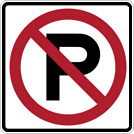 |
NO PARKING SYMBOL SIGN (R8-3) (a) Justification. The No Parking Symbol Sign (R8-3) shall be authorized for use to prohibit parking along a given highway. If the restriction applies to a limited area or zone, supplemental signs shall be authorized to show the limits of the restriction. Authorized supplemental signs include, but are not limited to the Restricted Hours Plaque (R10-20AP), No Parking Restricted Hours Plaque (R8-3HP-1), No Parking Loading Zone Plaque (R8-3GP-1), No Parking Arrow Plaque (R7-301), Tow-Away Zone Sign (R7-201AP), and No Parking On Pavement Sign (R8-3CP). As an alternate to the use of supplemental signs, the appropriate supplemental message and the no parking symbol may be incorporated into a single sign. (b) Size. The standard size R8-3 sign shall be 12 inches x 12 inches in business, residential, or park areas and 24 inches x 24 inches in rural areas. The standard size for expressways shall be 36 inches x 36 inches, and on freeways shall be 48 inches x 48 inches. (c) Placement. Signs should be set at an angle of not less than 30 degrees or more than 45 degrees with a line parallel to the flow of traffic so as to be visible to approaching traffic. Care should be taken to ensure that supplemental arrows point in the proper direction to indicated the regulated area. Signs shall be placed at the beginning of and at reasonable intervals throughout the restriction. |
 |
NO PARKING ON PAVEMENT PLAQUE (R8-3CP) (a) Justification. The No Parking On Pavement Plaque (R8-3CP) shall be authorized for use as a supplemental sign when parking is permissible off the pavement but prohibited on the pavement. When used, the R8-3CP sign shall be mounted directly below the No Parking Symbol Sign (R8-3). (b) Size. The R8-3CP sign shall be the same width as the R8-3 sign it supplements. |
 |
NO PARKING LOADING ZONE PLAQUE (R8-3GP-1) (a) Justification. The No Parking Lading Zone Plaque (R8-3GP-1) shall be authorized for use as a supplemental sign when it is necessary to reserve curb space for loading and unloading of commercial vehicles. When used, the R8-3GP-1 plaque should be mounted directly below the No Parking Symbol Sign (R8-3). (b) Size. The R8-3GP-1 plaque shall be the same width as the R8-3 sign it supplements. |
 |
NO PARKING RESTRICTED HOURS PLAQUE (R8-3HP-1) (a) Justification. The No Parking Restricted Hours Plaque (R8-3HP-1) shall be authorized for use as a supplemental sign in accordance with Department of Transportation regulations when parking is prohibited at certain times within a given area. The restricted hours and either "AM" or "PM" should be indicated on the R8-3HP-1 plaque. When used, the R8-3HP-1 plaque shall be mounted directly below the No Parking Symbol Sign (R8-3). (b) Size. The R8-3HP-1 plaque shall be the same width as the R8-3 sign it supplements. |
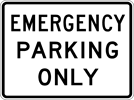 |
EMERGENCY PARKING ONLY SIGN (R8-4) The Emergency Parking Only Sign (R8-4) shall be authorized for use in rural areas when it is necessary to prohibit all parking except when vehicles must park because of mechanical breakdown, tire trouble, lack of fuel, or other emergencies involving vehicles or their occupants. The standard size of the R8-4 for expressways shall be 30 inches x 24 inches. |
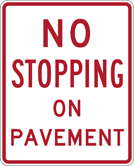 |
NO STOPPING ON PAVEMENT SIGN (R8-5) The No Stopping On pavement Sign (R8-5) shall be authorized for use in rural areas when stopping is permissible off the pavement but prohibited on the pavement. The R8-5 sign should be placed immediately in advance of and at intervals throughout the restricted area. The standard size for expressways shall be 36 inches x 48 inches, and on freeways shall be 48 inches x 60 inches. |
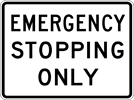 |
EMERGENCY STOPPING ONLY SIGN (R8-7) The Emergency Stopping Only Sign (R8-7) shall be authorized for use in rural areas when it is necessary to prohibit all stopping except when vehicles must park because of mechanical breakdown, tire trouble, lack of fuel, or other emergencies involving vehicles or their occupants. The standard size of the R8-7 for expressways shall be 30 inches x 24 inches. |
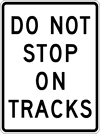 |
DO NOT STOP ON TRACKS SIGN (R8-8) (a) Justification. The Do Stop On Tracks Sign (R8-8) shall be authorized for use at those railroad crossings where it been determined there is extremely high potential that vehicles may stop on the tracks. (b) Placement. The R8-8 sign should normally be placed on the far right side of the grade crossing. On multi-lane or one-way highways a second sign should be placed on the far left side of the grade crossing. |
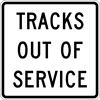 |
TRACKS OUT OF SERVICE SIGN (R8-9) The Tracks Out Of Service Sign (R8-9) may be used when a railroad track has been abandoned or its use discontinued. Authorization for use of this sign is to be determined by the Public Utility Commission. The R8-9 sign shall be removed only when the tracks have been removed or covered as determined by the Public Utility Commission. |
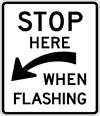 |
STOP HERE WHEN FLASHING (R8-10A) The Stop Here When Flashing Sign (R8-10A) may be used at a railroad grade crossing to inform drivers of the location of the stop line or the point at which to stop when the flashing-light signals are activated. |
 |
NO STOPPING ON BRIDGE SIGN (R8-20) (a) Justification. The No Stopping On Bridge Sign (R8-20) shall be authorized for use in rural areas when motorists have a tendency to stop or park on the bridge for other purposes than emergencies. (b) Size. The standard size for expressways shall be 30 inches x 24 inches. |
 |
WALK ON LEFT FACING TRAFFIC SIGN (R9-1) (a) Justification. The Walk On Left Facing Traffic Sign (R9-1) shall be authorized for use to encourage safer pedestrian habits along highways where no sidewalks are provided. (b) Placement. The R9-1 sign should be erected on the right-hand side of the road where pedestrians may walk on the pavement or shoulder in the absence of pedestrian pathways or sidewalks. |
| CROSS ONLY AT CROSSWALKS SIGN (R9-2) The Cross Only at Crosswalks Sign (R9-2) may be used where crosswalks are clearly defined to discourage jaywalking or unauthorized crossing. |
 |
NO PEDESTRIAN CROSSING SIGN (R9-3) (a) Justification. The No Pedestrian Crossing Sign (R9-3) shall be authorized for use at locations where there is existing or potential pedestrian activity, and an engineering study determines the need to restrict pedestrian movement. The sign shall be used to restrict pedestrians if a physical barrier is infeasible, and shall be used to supplement a physical barrier. The engineering study shall be approved by the District Traffic Engineer and Assistant District Executive, and shall document that at least one of the following conditions is satisfied:
The appropriate Use Crosswalk Plaque (R9-3BPR or R9-3BPL) or other special sign plaque, as necessary, should be used beneath the R9-3 sign to provide adequate pedestrian guidance to the appropriate crossing. (b) Placement. When used, the R9-3 sign should be positioned on the far end of the normal crosswalk area, facing pedestrians that would desire to cross the roadway. |
| USE CROSSWALK LEFT PLAQUE (R9-3BPL) The Use Crosswalk Left Plaque (R9-3BPL) shall be authorized beneath the No Pedestrian Crossing Sign (R9-3) to direct pedestrians to a crosswalk. |
| USE CROSSWALK RIGHT PLAQUE (R9-3BPR) The Use Crosswalk Right Plaque (R9-3BPR) shall be authorized beneath the No Pedestrian Crossing Sign (R9-3) to direct pedestrians to a crosswalk. |
 |
DO NOT PICK UP HITCHHIKERS SIGN (R9-4B) The Do Not Pick Up Hitchhikers Sign (R9-4B) may be used in areas where it is especially unwise to pick up a person soliciting rides. The R9-4B sign may be used in the surrounding areas where facilities such as prisons or hospitals are located. |
| SHARED-USE PATH RESTRICTION SIGN (R9-7) The Shared-Use Path Restriction (R9-7) sign may be installed to supplement a solid white pavement marking line on facilities that are to be shared by pedestrians and bicyclists in order to provide a separate designated pavement area for each mode of travel. The symbols may be switched as appropriate. |
 |
SIDEWALK CLOSED SIGN (R9-9) The Sidewalk Closed Sign (R9-9) may be used indicate the temporary closure of a sidewalk due to construction or other activities. |
 |
SIDEWALK CLOSED USE OTHER SIDE SIGN (R9-10) The Sidewalk Closed Use Other Side Sign (R9-10) may be used as applicable when a sidewalk is temporarily closed due to construction or other activities. A modified single-head arrow may be used as applicable. |
 |
SIDEWALK CLOSED CROSS HERE SIGN (R9-11A) The Sidewalk Closed Cross Here Sign (R9-11A) may be used to indicate the pedestrian crossing point when a sidewalk has been temporarily closed due to construction or other activities. |
| CROSS ON WALK SYMBOL ONLY SIGN (R10-2) (a) Justification. The Cross on Walk Symbol Only Sign (R10-2) shall be authorized for use to supplement symbol-type pedestrian signals or to aid in limiting pedestrian crossing to safe locations. (b) Placement. The R10-2 sign shall be placed only at intersections having pedestrian signals and shall be erected to face pedestrians about to cross the roadway. |
| PUSH BUTTON FOR WALKING PERSON SIGNAL SIGN (R10-3) The Push Button for Walking Person Signal Sign (R10-3) may be used at locations with walking person/upraised hand pedestrian signals where it is desired to permit pedestrians to register a demand for the walking person signal. The R10-3 sign should be mounted parallel to the desired crossing, immediately above the push button. The arrow shall point in the direction of the crossing. The finger in the push button symbol on the R10-3 sign should point in the same direction as the arrow the sign. |
| EDUCATIONAL PUSH BUTTON FOR WALKING PERSON SIGNAL SIGN (R10-3B) The Educational Push Button for Walking Person Signal Sign (R10-3B) may be used as an alternate to the R10-3 sign at locations with symbol-type pedestrian signal indications where it is desired to permit pedestrians to register a demand for the walking person signal and also to provide an educational message concerning the meaning of walking person/upraised hand pedestrian signals. The R10-3B sign should be mounted parallel to the desired crossing, immediately above the push button. The arrow shall point in direction of the crossing. |
| EDUCATIONAL PUSH BUTTON FOR WALK SIGNAL WITH COUNTDOWN TIMER SIGN (R10-3E) The Educational Push Button for Walk Signal with Countdown Timer Sign (R10-3E) may be used as an alternate to the R10-3 sign at locations with symbol-type pedestrian signal indications and a countdown timer to help educate pedestrians as to the meaning of the symbols and the countdown timer. When used, the R10-3E sign should be mounted parallel to the desired crossing, immediately above the push button. The arrow shall point in direction of the crossing. |
| PUSH BUTTON FOR GREEN SIGNAL SIGN (R10-4) The Push Button For Green Signal Sign (R10-4) may be at locations where it is desired to permit pedestrians to register a demand for the green signal. The R10-4 sign should be mounted parallel to the desired crossing, immediately above the push button. The arrow shall point in the direction of the crossing. The finger in the pushbutton symbol on the R10-4 sign should point in the same direction as the arrow on the sign. |
 |
LEFT ON GREEN ARROW ONLY SIGN (R10-5) (a) Justification. The Left On Green Arrow Only Sign (R10-5) may be used at signalized intersections where left-turning vehicles are permitted to turn left only on a left green arrow. (b) Placement. When used, the R10-5 sign shall be installed adjacent to the left turn signal. (c) Size. The standard size of the R10-5 sign shall be 30 inches x 36 inches for post-mounted and overhead installations. |
 |
STOP HERE ON RED SIGN (R10-6AL) (a) Justification. The Stop Here On Red Sign (R10-6AL) shall be authorized for use at signalized intersections to indicate the stopping point for vehicles when the stopping location must be placed further than normal from the intersection. (b) Placement. The R10-6AL sign should be placed on the right and must be supplemented by a stop line in accordance with Department of Transportation regulations (relating to stop lines). |
 |
STOP HERE ON RED SIGN (R10-6AR) (a) Justification. The Stop Here On Red Sign (R10-6AR) shall be authorized for use on divided streets at signalized intersections to indicate the stopping point for vehicles when the stopping location must placed further than normal from the intersection. (b) Placement. The R10-6AR sign should be placed in the median on the left and must be supplemented by a stop line in accordance with Department of Transportation regulations (relating to stop lines). |
 |
LEFT LANE PLAQUE (R10-6-1) The Left Lane Plaque (R10-6-1) may be used above a Stop Here On Red Sign (R10-6AL or R10-6AR) when the stop line for the left lane at a signalized intersection is at a different location than the stop line for the right lane. |
 |
DO NOT BLOCK INTERSECTION SIGN (R10-7) (a) Justification. The Do Not Block Intersection Sign (R10-7) shall be authorized for use where stopped traffic frequently blocks an intersection. When the condition is other than an intersection, the specific condition, such as DRIVEWAY, may be used in place if the word INTERSECTION. (b) Placement. The R10-7 sign shall be placed immediately in advance of the street or other crossing which must be kept open. |
 |
LEFT TURN SIGNAL SIGN (R10-10L) (a) Justification. The Left Turn Signal Sign (R10-10L) shall be authorized for use with and is to be located close to a specific signal controlling a left-turning movement. |
 |
RIGHT TURN SIGNAL SIGN (R10-10R) (a) Justification. The Right Turn Signal Sign (R10-10R) shall be authorized for use with and is to be located close to a specific signal controlling a right-turning movement. |
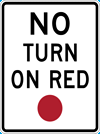 |
NO TURN ON RED SYMBOL SIGN (R10-11) (a) Justification. The No Turn On Red Symbol Sign (R10-11) shall be used to prohibit a right turn on red (or a left turn on red from a one-way street to a one-way street) when an engineering study indicates that the restriction is warranted. If the no turn on red restriction applies only at certain times of the day or days of the week, the R10-11 sign or the R10-101 sign may be used as necessary. (b) Placement. When used, the R10-11 sign should be installed near the appropriate signal head. If a sign cannot be erected within 10 feet of the appropriate signal head, two signs shall be installed. These two signs shall be installed on the appropriate side of the roadway with one sign installed on the far side of the intersection and one sign post-mounted near the stop line or in advance of a marked or unmarked crosswalk. (c) Size. The standard size of the R10-11 sign shall be 24 inches x 30 inches for single lane conventional highways and 36 inches x 48 inches for multi-lane conventional highways. |
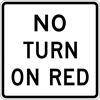 |
NO TURN ON RED SQUARE-SHAPED SIGN (R10-11B) (a) Justification. The No Turn On Red Square-Shaped Sign (R10-11B) may be used as an alternate to the No Turn on Red Symbol Sign (R10-11) to prohibit a right turn on red (or a left turn on red from a one-way street to a one-way street) when an engineering study indicates that the restriction is warranted but only at specific times. When used, the Restricted Hours Plaque (R10-20AP) should be used below the R10-11B sign. If time restrictions can be put on a single line, the No Turn On Red with One-Line Restriction Sign (R10-101) should be used. The R10-11B sign may also be used if the standard R10-11 sign cannot be installed due to field conditions such as vertical clearance restrictions. (b) Placement. When used, the R10-11B sign should be installed near the appropriate signal head. If a sign cannot be erected within 10 feet of the appropriate signal head, two signs shall be installed. These two signs shall be installed on the appropriate side of the roadway with one sign installed on the far side of the intersection and one sign post-mounted near the stop line or in advance of a marked or unmarked crosswalk. |
 |
NO TURN ON RED EXCEPT FROM RIGHT LANE SIGN (R10-11C) The No Turn On Red Except From Right Lane Sign (R10-11C) may be post-mounted on signalized approaches with more than one right-turn lane. |
 |
NO TURN ON RED FROM THIS LANE (R10-11D) On signalized approaches with more than one right turn lane, the No Turn On Red From This Lane (R10-11D) Sign may be mounted directly over the center of the lane from which turns on red are prohibited. |
 |
LEFT TURN YIELD ON GREEN SIGN (R10-12) (a) Justification. The Left Turn Yield On Green Sign (R10-12) may be used when a left-turning movement on an approach is protected by the display of a left green arrow during one phase of the traffic signal operation, and also permitted by the display of a circular green during another phase. The R10-12 sign may also be used, on a temporary basis, to notify drivers of a change in operation when a protected/permitted left turn phase is converted to a permitted left turn phase. (b) Placement. The R10-12 sign should be placed near the traffic signal which displays the left green arrow. |
 |
LEFT TURN YIELD ON FLASHING YELLOW ARROW SIGN (R10-12A) (a) Justification. The Left Turn Yield On Flashing Yellow Arrow Sign (R10-12A) shall be used when a left-turning movement on an approach is permitted by the display of a left flashing yellow arrow. (b) Placement. The R10-12A sign should be placed near the traffic signal which displays the left flashing yellow arrow. |
 |
EMERGENCY SIGNAL SIGN (R10-13) (a) Justification. The Emergency Signal Sign (R10-13) shall be authorized for use at locations where a traffic-control signal is installed to obtain the right-of-way for an emergency vehicle. (b) Placement. The R10-13 sign shall be located adjacent to the overhead signal for each street approach. |
 |
TURNING TRAFFIC MUST YIELD TO PEDESTRIANS (LEFT) SIGN (R10-15L) (a) Justification. The Turning Traffic Must Yield To Pedestrians (Left) Sign (R10-15L) may be installed as a ground-mounted sign to remind drivers who are making left turns to yield to pedestrians, especially at intersections where left turn on red is permitted and pedestrian cross walks are marked. |
 |
TURNING TRAFFIC MUST YIELD TO PEDESTRIANS (RIGHT) SIGN (R10-15R) (a) Justification. The Turning Traffic Must Yield To Pedestrians (Right) Sign (R10-15R) may be installed as a ground-mounted sign to remind drivers who are making right turns to yield to pedestrians, especially at intersections where right turn on red is permitted and pedestrian cross walks are marked. |
 |
U-TURN YIELD TO RIGHT TURN SIGN (R10-16) The U-Turn Yield To Right Turn Sign (R10-16) may be installed near the left-turn signal face if u-turns are allowed on a protected left-turn movement on an approach from which a right-turn green arrow signal indication is simutaneously being displayed to drivers making a right turn from the conflicting approach to their left. |
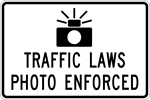 |
TRAFFIC LAWS PHOTO ENFORCED SIGN (R10-18) The Traffic Laws Photo Enforced Sign (R10-18) may be installed at a jurisdictional boundary to advise road users that some of the traffic regulations within that jurisdiction are being enforced by photographic equipment. The R10-18 sign may also be installed within a jurisdiction along corridors or in other geographic areas where traffic regulations are being enforced by photographic equipment. The standard size of the R10-18 sign shall be 36 inches x 24 inches for single-lane and multi-lane conventional roadways and 54 inches x 36 inches for freeways. |
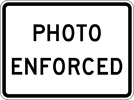 |
PHOTO ENFORCED SIGN (R10-19AP) (a) Justification. The Photo Enforced Sign (R10-19AP) may be mounted below a regulatory sign to advise road users that the regulation is being enforced by photographic equipment. The R10-19AP sign may also be mounted alone on traffic control signal support to advise road users that an automated red light enforcement system is in use. (b) Size. The standard size of the R10-19AP sign when mounted alone overhead on a traffic control signal support shall be 36 inches x 30 inches. When used on an expressway, the standard size of the R10-19AP shall be 36 inches x 30 inches. When used on a freeway, the standard size of the R10-19AP shall be 48 inches x 36 inches. |
 |
RESTRICTED HOURS PLAQUE (R10-20AP) The Restricted Hours Plaque (R10-20AP) may be used as a supplemental sign beneath any turn prohibition sign or the No Turn On Red Square-Shaped Sign (R10-11B) to designate the effective hours of the restriction. The R10-20AP plaque may also be used in conjunction with the Speed Limit Sign (R2-1) when identifying a school zone speed limit and the No Parking Symbol Sign (R8-3). Th. R10-20AP plaque shall have a maximum of three lines, except when used for a school zone speed limit roadways with a normal speed limit of 35 MPH or less. The first line may be used to designate the effective days of the week. The R10-20AP plaque shall be mounted below the primary sign, and shall have the same width as the primary sign. |
| PUSH BUTTON TO TURN ON WARNING LIGHTS SIGN (R10-25) The Push Button to Turn on Warning Lights Sign (R10-25) is authorized for use where is is desired to inform pedestrians to activate the flashing warning lights to assist pedestrians in making a safe crossing. The R10-25 sign may also be used at locations where push buttons have been provided to activate beacons, firehouse warning services, or emergency traffic signals. When installed for pedestrians, the R10-25 sign should be mounted parallel to the desired crosswalk, immediately above the push button. When installed for other purposes, the R10-25 sign should be in close proximity to the push button. |
 |
ONE VEHICLE PER GREEN SIGN (R10-28) The One Vehicle Per Green Sign (R10-28) may be erected on one lane approaches to ramp metering signals to indicate that only one vehicle may proceed during the green light indication. |
 |
ONE VEHICLE PER GREEN EACH SIGN (R10-29) The One Vehicle Per Green Each Lane Sign (R10-29) may be erected on two lane approaches to ramp metering signals to indicate that only one vehicle per lane may proceed during the green light indication. |
 |
NO TURN ON RED WITH ONE-LINE RESTRICTION SIGN (R10-101) (a) Justification. The No Turn On Red with One-Line Restriction Sign (R10-101) may be used as an alternate to the No Turn on Red Square-Shaped Sign (R10-11B) to prohibit a right turn on red (or a left turn on red from a one-way street to a one-way street) when an engineering study indicates that the restriction is warranted but only at a specific time. When used, the restriction should be inserted in the last line. Appropriate restrictions include but are not limited to "MON-FRI" or "7-9AM". (b) Placement. When used, the R10-101 sign should be installed near the appropriate signal head. If a sign cannot be erected within 10 feet of the appropriate signal head, two signs shall be installed. These two signs shall be installed on the appropriate side of the roadway with one sign installed on the far side of the intersection and one sign post-mounted near the stop line or in advance of a marked or unmarked crosswalk. |
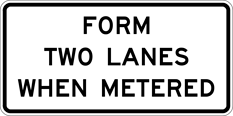 |
FORM TWO LANES WHEN METERED SIGN (R10-102) The Form Two Lanes When Metered Sign (R10-102) may be used on entrance ramps that have two lanes provided for ramp metering to advise motorists to use both lanes during the ramp meter period. |
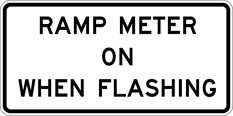 |
RAMP METER ON WHEN FLASHING SIGN (R10-103) The Ramp Meter On When Flashing Sign (R10-103) may be used at ramp metering locations to indicate that ramp traffic may be metered. The R10-103 sign shall be used in conjunction with flashing beacons that indicate when ramp meter is activated. |
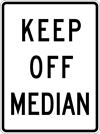 |
KEEP OFF MEDIAN SIGN (R11-1) The Keep Off Median Sign (R11-1) may be used on the left of the roadway within the median wherever there is a tendency for drivers to enter upon or cross it, and at random intervals as needed. Where space within the median is limited, however, the sign may be erected the right of the roadway. The minimum size for use on freeways and expressways shall be 36 inches x 48 inches. |
 |
ROAD CLOSED SIGN (R11-2) The Road Closed Sign (R11-2) shall be authorized for use to mark highways that have closed to all traffic, except equipment of contractors and other authorized vehicles, either because of construction or maintenance operations or because of a temporary emergency. The word "RAMP" may be substituted for the word "ROAD' when a ramp has been closed in accordance with the provisions obove. The R11-2 sign should be mounted on a Type III Barricade. |
 |
BRIDGE CLOSED SIGN (R11-2-1) (a) Justification. The Bridge Closed Sign (R11-2-1) may be used to sign bridges that have been closed to all traffic. (b) Placement. The R11-2-1 sign should be mounted on a Type III Barricade. |
 |
ROAD CLOSED — LOCAL TRAFFIC ONLY SIGN (R11-3A) The Road Closed — Local Traffic Only Sign (R11-3A) may be used where through traffic must detour to avoid a closed highway some distance beyond, but where the road is open to traffic up to the point of closure. An intersecting street name or a well-known destination may be substituted for the (__) MILES AHEAD legend in urban areas. |
| BRIDGE OUT — LOCAL TRAFFIC ONLY SIGN (R11-3B) The Bridge Out — Local Traffic Only Sign (R11-3B) may be used where through traffic must detour to avoid a closed highway. An appropriate legend describing the circumstances of the closing, such as "BRIDGE OUT", "HIGH WATER", or "SLIDES" may be placed over the words "ROAD CLOSED" on the Road Closed — Local Traffic Only Sign (R11-3A). |
 |
ROAD CLOSED TO THRU TRAFFIC SIGN (R11-4) The Road Closed To Thru Traffic Sign (R11-4) may be used in urban areas where a highway is closed due to construction, maintenance, other temporary emergency. "STREET" may be used in place of "ROAD". |
 |
CLOSED FOR THE SEASON SIGN (R11-6) (a) Justification. The Closed For The Season Sign (R11-6) shall be authorized for use on non-Interstate Rest Areas which have been closed for the season. (b) Placement. The R11-6 sign should be placed on a red and white striped baracade closing the area. |
 |
TRUCKS KEEP OFF SHOULDER SIGN (R11-7) (a) Justification. The Trucks Keep Off Shoulder Sign (R11-7) shall be authorized at locations where trucks frequently travel on the shoulder but the shoulder is not capable of supporting truck traffic. (b) Placement. The R11-7 sign shall be erected immediately in advance of and at intervals throughout the restricted area. |
 |
STREET CLOSED (__) TO (__) SIGN (R11-10) (a) Justification. The Street Closed (__) to (__) Sign (R11-10) shall be authorized for use where the street is closed by local authorities for special activities. The word "ROAD" may be used in place of "STREET". (b) Placement. The R11-10 sign shall be placed on a Type III barricade in the center of the street. |
 |
SNOWMOBILE ROAD — CLOSED TO ALL OTHER VEHICLES SIGN (R11-11) (a) Justification. The Snowmobile Road — Closed To All Other Vehicles Sign (R11-11) may be used when a street or highway has been closed to all vehicular traffic other than snowmobiles and designated as a snowmobile road by the governmental agency having jurisdiction over the street or road. (b) Placement. The R11-11 sign should be mounted on a Type III, red and white reflectorized barricade in the center of the roadway, or if the pavement width does not permit, at the right side of the roadway. |
 |
ATV ROAD — CLOSED TO ALL OTHER VEHICLES SIGN (R11-11-1) (a) Justification. The ATV Road — Closed To All Other Vehicles Sign (R11-11-1) may be used when a street or highway has been closed to all vehicular traffic other than ATVs and designated as an ATV road by the governmental agency having jurisdiction over the street or road. (b) Placement. The R11-11 sign should be mounted on a Type III, red and white reflectorized barricade in the center of the roadway, or if the pavement width does not permit, at the right side of the roadway. |
 |
SNOWMOBILE — ATV ROAD CLOSED TO ALL OTHER VEHICLES SIGN (R11-11-2) Justification. The Snowmobile — ATV Road Closed To All Other Vehicles (R11-11-2) may be used when a street or highway has been closed to all vehicular traffic other than snowmobiles and ATVs and designated as a joint snowmobile-ATV road by the governmental agency having jurisdiction over the street or road. (b) Placement. The R11-11 sign should be mounted on a Type III, red and white reflectorized barricade in the center of the roadway, or if the pavement width does not permit, at the right side of the roadway. |
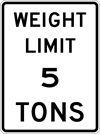 |
WEIGHT LIMIT (__) TONS SIGN (R12-1) (a) Justification. The Weight Limit (__) Tons Sign (R12-1) sign shall be authorized to restrict the weight permitted on a highway or bridge when an engineering and traffic study determines that restriction is warranted. When used to advise of a weight restriction on a bridge, the Bridge Sign (R12-1-2) shall be mounted directly above the R12-1 sign. (b) Placement. The R12-1 sign shall be located within 25 feet of each end of the bridge or section of highway to which it applies (75 Pa.C.S. § 4902 (e) ). In the case of an extended length of highway, it shall be placed on the right hand side of the restricted highway not more than 25 feet beyond any intersection so as to be clearly visible from all vehicles about to enter the restricted highway. A supplementary sign may be necessary on the left-hand side of the highway. (c) Size. The standard size of the R12-1 sign shall be 24 inch x 30 inch. |
 |
BRIDGE LIMITED TO ONE TRUCK SIGN (R12-1A) (a) Justification. The Bridge Limited To One Truck Sign (R12-1A) may be used in advance of a bridge when a bridge for load rating using a single vehicle indicates that based on the current Department of Transportation posting policy no bridge weight restriction or less bridge restrictive bridge weight restrictions would result when only one truck is allowed on the bridge at any one time. This sign may be used only when the District Bridge Engineer or the Municipal Engineer judges that the bridge is a candidate for the application of this sign and one of the following conditions is met:
(b) Placement. When used, the R12-1A sign should be placed in advance of all approaches to the applicable bridge. The R12-1A sign may be erected alone or it may be erected beneath the Bridge Weight Limit (__) Tons Sign (R12-1 and R12-1-2) and the Except Combinations (__) Tons Sign (R12-5A). |
| BRIDGE SIGN (R12-1-2) (a) Justification. The Bridge Sign (R12-1-2) shall be mounted above the Weight Limit Sign (R12-1) when applicable. As an advance warning it shall also be used in conjunction with the Distance Ahead Plaque (W16-103P). (b) Size. The size shall be determined by and be in accord with the size of the sign to which it is appended. |
| WEIGHT LIMIT FOR SAFETY PLAQUE (R12-1-3) The Weight Limit For Safety Plaque (R12-1-3) shall be authorized for use to supplement a Weight Limit (__) Tons Sign (R12-1), an Except Combinations (__) Tons (R12-5A), or a No Trucks Sign (R5-2) when the weight limit or prohibition of trucks was approved because of hazardous traffic conditions or other safety factors rather than for a structural deficiency of the bridge or roadway. The R12-1-3 plaque should not be used when the Distance Ahead Plaque (W16-103P) is used. (b) Placement. When used, the R12-1-3 plaque shall be placed beneath the R5-2, R12-1, or R12-5A sign. |
 |
SEASONAL WEIGHT LIMIT SIGN (R12-1-4) (a) Justification. The Seasonal Weight Limit Sign (R12-1-4) may be used in accordance with an engineering and traffic study when the roadway is weakened because of climatic conditions, especially during the spring thaw. The restriction should identify the applicable months (abbreviations may be used as necessary) and is not limited to the months depicted in the image. Designations such as "NOV THRU APRIL" may be used when it is not possible to identify each applicable month. (b) Placement. The R12-1-4 sign should be installed beneath the Weight Limit (__) Tons Sign (R12-1) and any other plaques. (c) Size. The width of the R12-1-4 sign should be the same as the width of the R12-1 sign. |
 |
EXCEPT COMBINATIONS (__) TONS SIGN (R12-5A) (a) Justification. The Except Combinations (__) Tons Sign (R12-5A) may be used to permit the weight of vehicle combinations on a highway or bridge to exceed the weight limit for single-unit vehicles. (b) Placement. When used, the R12-5A sign shall be placed beneath the Weight Limit (__) Tons Sign (R12-1). (c) Size. The R12-5A sign shall be the same width as the R12-1 sign it supplements. |
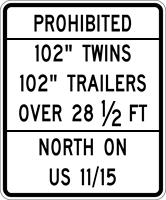 |
102-INCH WIDE TRAILER ADVANCE PROHIBITED SIGN (R12-6) The R12-6 sign may be installed on a numbered traffic route where 102-inch wide trailers authorized, to advise truckers that the specified types of 102-inch wide trailers are prohibited on an intersecting numbered traffic route based on safety reasons. When used, the sign should be installed at a location where trucks can avoid entrapment. A R12-6A sign should generally be installed on the second numbered traffic route. The largest size sign is recommended on all roadways where prevailing travel speeds are greater than 40 MPH. The smallest size sign is authorized on single lane conventional highways where the speed limit is 25 MPH and on other roadways and on other roadways where space does not exist for a larger size sign. The "28 1/2 FT" may be increased to restrict other trailer lengths as appropriate. The "NORTH ON US 11/15" is also an example. Depending on the required legend, the height of the R12-6 sign may need to be altered. |
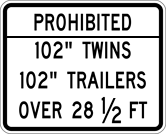 |
102-INCH WIDE TRAILER PROHIBITED SIGN (R12-6A) The R12-6A sign is an optional sign that may be installed at the beginning of the actual restriction based on safety reasons. The largest size sign is recommended on all roadways where prevailing travel speeds are greater than 40 MPH. The smallest size sign is authorized on single lane conventional highways where the speed limit is 25 MPH and on other roadways where space does not exist for a larger size sign. The "28 1/2 FT" may be increased to restrict other trailer lengths as appropriate. |
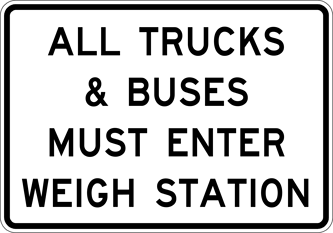 |
ALL TRUCKS & BUSES MUST ENTER WEIGH STATION SIGN (R13-1-1) (a) Justification. The All Trucks & Buses Must Enter Weigh Station Sign (R13-1-1) is authorized for use in advance of a weigh station to inform the operators of trucks & buses that they must enter the weigh station. When the weigh station is not in operation, this sign shall be folded or covered or a subsequent sign shall be used to advise that the station is open or closed. The R13-1-1 sign shall be erected following the Advance Weigh Station Sign (D8-1) and prior to the Weigh Station Next Right Sign (D8-2) if utilized, and the Weigh Station Sign (D8-3). (b) Size. The standard size R13-1-1 sign shall be 120 inches x 84 inches on freeways, 96 inches x 66 inches on expressways, and 72 inches x 48 inches on all other highways. The 72 inches x 48 inches size may, however, be used on any type roadway for mobile or semi-permanent weighing operations. |
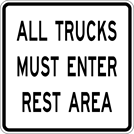 |
ALL TRUCKS MUST ENTER REST AREA SIGN (R13-2) The All Trucks Must Enter Rest Area Sign (R13-2) may be used in advance of a weigh station in a rest area to inform the truck drivers that they must enter the rest area. When the weigh station is not in operation, this sign shall be covered, folded, or removed. The R13-2 sign shall be erected following the Advance Weigh Station Sign (D8-1) and prior to the rest area entrance. |
 |
TRUCK ROUTE SIGN (R14-1) (a) Justification. The Truck Route Sign (R14-1) shall be authorized for use to mark an unnumbered highway which has been designated by proper authority as a truck route where height or weight limitations or other truck exclusions have been imposed on alternate routes. The black on white turn markers provided in M5 or M6-Series Signs may be used with the R14-1 sign to indicate turns in the truck route. On a numbered highway Truck Marker (M4-4) will be applicable. |
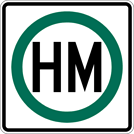 |
HAZARDOUS MATERIAL ROUTE SIGN (R14-2) The Hazardous Material Route Sign (R14-2) may used to mark highways which have been designated by the authorities having jurisdiction over the highway for vehicles transporting hazardous materials and where an exclusion for such vehicles has been imposed on alternate highways. |
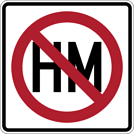 |
HAZARDOUS MATERIAL PROHIBITED SIGN (R14-3) The Hazardous Material Prohibition Sign (R14-3) may be used to mark highways where the transportation of hazardous materials on the highway is prohibited by the authorities having jurisdiction over the highway. The sign should be installed on a street or highway at a point where vehicles transporting hazardous materials have the opportunity to take an alternative route. |
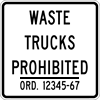 |
WASTE TRUCKS PROHIBITED SIGN (R14-6) The Waste Trucks Prohibited Sign (R14-6) may be placed along certain highways where municipal ordinances regulate the routes of travel for the transport of ashes, garbage, rubbish, or other refuse material in motor vehicles. Signs may only be placed on routes which are designated by municipal ordinance. Also, signs may only be placed if another acceptable alternate roadway is available within the municipality. |
 |
BRAKE RETARDERS PROHIBITED SIGN (R14-9) The Brake Retarders Prohibited Sign (R14-9) may be used to restrict the use of engine retarding brakes on trucks. This sign shall only be erected when the Department of Transportation has authorized the enactment of a municipal ordinance prohibiting the use of brake retarders (as defined in Department of Transportation regulations). The word "MUNICIPAL" may be replaced with "CITY", "BOROUGH", or "TOWNSHIP" as appropriate, or the name of the municipality, or the lower portion of the sign can state whatever the actual restriction is. The size of the sign may be increased as necessary to accommodate the legend. |
 |
END BRAKE RETARDER PROHIBITION SIGN (R14-9A) The End Brake Retarder Prohibition Sign (R14-9A) may be used in conjunction with the Brake Retarders Prohibited Sign (R14-9) to the point where the restriction no longer applies, when the restriction does not end at a municipal boundary. |
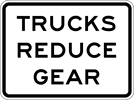 |
TRUCKS REDUCE GEAR SIGN (R14-10) (a) Justification. The Trucks Reduce Gear Sign (R14-10) shall be authorized for use on those downgrades where commercial motor vehicles or truck tractors and trailers or semi-trailers shall be required to use a reduced gear before descending the downgrade. (b) Placement. The R14-10 sign shall be placed so that any truck passing it will have time to slow down and reduce gear before entering the downgrade. |
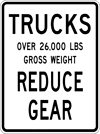 |
TRUCKS OVER (__) LBS. GROSS WEIGHT REDUCE GEAR SIGN (R14-11) (a) Justification. The Trucks Over (__) Lbs. Gross Weight Reduce Gear Sign (R14-11) shall be authorized for use on those grades where certain classes of commercial vehicles or truck tractors and trailers or semi-trailers shall be required by this sign to use a reduced gear. (b) Placement. The R14-11 sign shall be placed so that any truck passing it will have time to slow down and reduce gear before entering the downgrade. This sign may be placed above the Trucks Over (__) Lbs. Speed Sign (R2-2-1). |
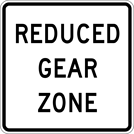 |
REDUCED GEAR ZONE SIGN (R14-12) (a) Justification. The Reduced Gear Zone Sign (R14-12) shall be authorized for use within the limits of a reduced gear zone in conjunction with the Trucks Over (__) Lbs. Gross Weight Reduce Gear Sign (R14-11). (b) Placement. The R14-12 sign may be erected alone, or in a series with other signs, and shall be placed at reasonable intervals. (c) Size. The standard size of the R14-12 sign shall be 30 inches x 30 inches. |
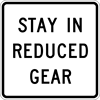 |
STAY IN REDUCED GEAR SIGN (R14-12-1) (a) Justification. The Stay In Reduced Gear Sign (R14-12-1) shall be authorized for use on those grades where a reduced gear zone is necessary for safety reasons. (b) Placement. The R14-12-1 sign may be erected alone or it may be erected beneath the Trucks Over (__) Lbs. Speed Sign (R2-2-1). (c) Size. When used beneath the R2-2-1 sign, the R14-12-1 sign shall have the same width as the R2-2-l sign which it supplements. |
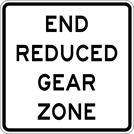 |
END REDUCED GEAR ZONE SIGN (R14-13) (a) Justification. The End Reduced Gear Zone Sign (R14-13) shall be authorized for use to mark the ending of a reduced gear zone. (b) Placement. The R14-13 sign shall be placed at the end of all zones which have a Trucks Over (__) Lbs. Gross Weight Reduce Gear Sign (R14-11) placed at the beginning. (c) Size. The standard size of the R14-13 sign shall be 30 inches x 30 inches. |
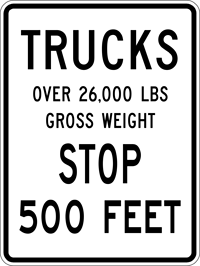 |
TRUCKS OVER (__) LBS. STOP (__) FEET SIGN (R14-14) (a) Justification. The Trucks Over (__) Lbs. Stop (__) Feet Sign (R14-14) may be used on those downgrades where certain classes of commercial motor vehicles or truck tractors and trailers or semi-trailers shall be required to stop before descending the downgrade. (b) Placement. The R14-14 shall be placed in advance of the point where said vehicle must stop. (c) Size. The standard size is 48 inches x 60 inches. |
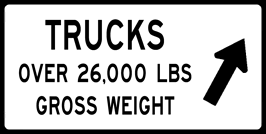 |
TRUCKS OVER (__) LBS. WITH ARROW SIGN (R14-15) (a) Justification. The Trucks Over (__) Lbs. With Arrow Sign (R14-15) may be used at the point where certain classes of commercial motor vehicles or truck tractors and trailers or semi-trailers are required to leave the main traveled portion of the highway in conjunction with Trucks Over (__) Lbs. Stop (__) Feet Sign (R14-14). (b) Size. The standard size is 72 inches x 36 inches. |
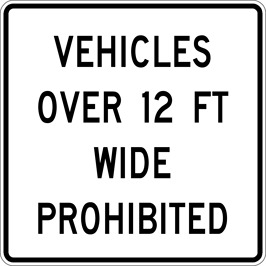
|
VEHICLES OVER (__) FT WIDE PROHIBITED SIGN (R14-16-1) (a) Justification. The Vehicles Over (__) Ft Prohibited Sign (R14-16-1) may be used where restricted roadway widths or other conditions will not accommodate vehicles or loads over a certain width. The 36 inch x 36 inch size should be limited to conventional roads with restricted lateral clearance. Supplemental plaques such as "BEYOND EXIT __", "BEYOND NEXT EXIT", "BEYOND NEXT INTERSECTION" may be added as necessary. |
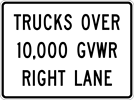 |
TRUCKS OVER 10,000 GVWR RIGHT LANE SIGN (R14-17) The Trucks Over 10,000 GVWR Right Lane Sign (R14-17) shall be used on multi-lane highways conventional highways at a location following the Truck Inspection Ahead Sign (W25-102) and prior to the Trucks Over 10,000 GVWR Enter Sign (R14-18) sign. The sign should be removed as soon as truck inspection operations are complete. |
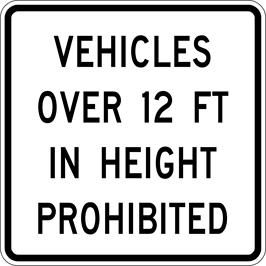
|
VEHICLES OVER (__ ) FEET IN HEIGHT PROHIBITED (R14-17-1) The Vehicles Over (__) Feet In Height Prohibited Sign (R14-17-1) may be used where restricted clearances or other conditions will not accommodate vehicles or loads over a certain height. Supplemental plaques such as "BEYOND EXIT __", "BEYOND NEXT EXIT", "BEYOND NEXT INTERSECTION" may be added as necessary. |
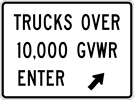 |
TRUCKS OVER 10,000 GVWR ENTER SIGN (R14-18) The Trucks Over 10,000 GVWR Enter Sign (R14-18) shall be used to indicate the location where trucks are to pull off the roadway for truck inspection. The sign should be used in conjunction with the Trucks Over 10,000 GVWR Right Lane Sign (R14-17) and/or the Truck Inspection Ahead Sign (W25-102) as appropriate. The sign should be removed as soon as truck inspection operations are complete. |
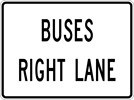 |
BUSES RIGHT LANE SIGN (R14-19) The Buses Right Lane Sign (R14-19) shall be used on multi-lane highways at a location following the Bus Inspection Ahead Sign (W25-3) and prior to the Buses Enter Here Sign (R14-20). The sign should be removed as soon as bus inspection operations are complete. |
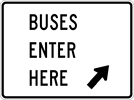 |
BUSES ENTER HERE SIGN (R14-20) The Buses Enter Here Sign (R14-20) shall be used to indicate the specific location where buses are to pull off the roadway for bus inspection. The sign should be used in conjunction with the Buses Right Lane Sign (R14-19) and/or the Bus Inspection Ahead Sign (W25-3). The sign should be removed as soon as bus inspection operations are complete. |
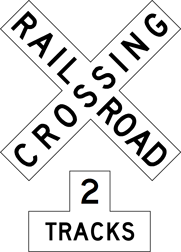 |
RAILROAD CROSSBUCK SIGN (R15-1) AND TRACKS SIGN (R15-2P) (a) Justification. The Railroad Crossbuck Sign (R15-1) shall be authorized for use on the right side of the roadway on each approach to a highway-rail grade crossing. Where restricted sight distance or unfavorable highway geometry exists on an approach to a highway-rail grade crossing, an additional R15-1 sign shall also be installed on the left side of each approach. A minimum of 2 inch width of white Type VII or IX retroreflective sheeting shall be applied to the center line on the back of each crossbuck blade except when crossbucks are installed back-to-back. A similar 2 inch width retroreflective sheeting shall also be applied vertically on the front and back side of the supports, except not on the side with a flashing light, or a stop or yield sign. (b) Placement. The R15-1 sign shall be installed within 12 feet to 15 feet from the centerline of the nearest track. It shall not be less than 6 feet or more than 12 feet from the edge of the pavement, or less than 2 feet outside a paved shoulder or curb. The Tracks Sign (R15-2P) indicating the number of tracks shall be mounted below the R15-1 when there are two or more tracks, including sidings. (c) Posting Responsibility. The R15-1 and R15-2P signs shall be furnished and installed by the railroad company, typically within the railroad right-of-way. |
| EXEMPT RAILROAD CROSSING SIGN (R15-3P) (a) Justification. The Exempt Railroad Sign (R15-3P) shall be authorized for use at those railroad grade crossings having exempt status as determined by the Public Utility Commission. (b) Placement. The R15-3P sign, when used, shall be mounted below the Railroad Crossbuck Sign (R15-1) or the Tracks Sign (R15-2P) on each highway approach to the railroad grade crossing. The R15-3P sign should be installed by Pennsylvania Department of Transportation or local officials after the crossing is declared exempt by the Public Utility Commission. |
 |
HIGH SPEED TRAINS SIGN (R15-101) (a) Justification. The High Speed Trains Sign (R15-101) may be used at railroad-highway grade crossings where it is necessary to inform drivers that the rail line is used by high speed trains. It shall be used only where authorized by the Public Utility Commission. (b) Placement. When authorized, the R15-101 sign shall be furnished and installed by the railroad company below the Railroad Crossbuck Sign (R15-1) and/or Tracks Sign (R15-2P) on each highway approach to the railroad crossing. |
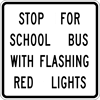 |
SCHOOL BUS LAW SIGN (R16-1) (a) Justification. The School Bus Law Sign (R16-1) shall be authorized for use to advise the motorist of the legal requirement to stop for school buses with flashing red signal lights. (b) Placement. The R16-1 sign may be placed at all major vehlcular entrance points into the Commonwealth and at other locations where obedience is unsatisfactory. |
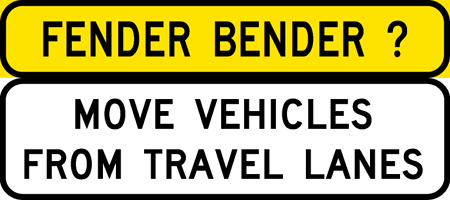 |
FENDER BENDER SIGN (R16-4) The Fender Bender Sign (R16-4) may be used on freeways, expressways, and major arterials in urban areas to direct drivers to move their vehicles from the travel lane(s) when involved in a fender-bender type crash. |
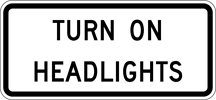 |
TURN ON HEADLIGHTS SIGN (R16-8) (a) Justification. The Turn On Headlights Sign (R16-8) may be used in advance of any location where it has been deemed necessary to advise drivers to turn on their headlights before entering the location. (b) Placement. When used, the R16-8 sign should be placed a minimum distance in feet equal to 10 times the speed limit in MPH, in advance of the location. |
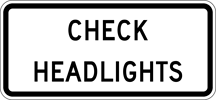 |
CHECK HEADLIGHTS SIGN (R16-9) The Check Headlights Sign (R16-9) may be used in conjunction with the Turn On Headlights Sign (R16-8). The R16-9 sign is a courtesy reminder to the drivers that their headlights may no longer be necessary. (b) Placement. The R16-9 sign should be placed downstream from the special situation for which the R16-8 sign was posted. |
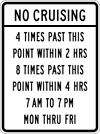 |
NO CRUISING SIGN (R16-101) (a) Justification. The No Cruising Sign (R16-101) may be used to indicate that vehicular traffic, other than governmental, public safety, emergency or public transportation traffic is prohibited by ordinance from traversing past a designated point a specific number of times within a specific time period or periods; commonly referred to as "cruising". (b) Design. The standard R16-101 shall have only the message "NO CRUISING" and whatever regulation may apply; but the sign shall conform with the standards of shape, color and minimum size established here. Generally, a No Cruising Sign (R16-101) should display the following information, as appropriate, from top to bottom on this sign in the following order:
(c) Placement. The No Cruising Sign shall be placed as indicated in the local ordinance except that a sign shall be erected at the beginning of the restriction on each street or highway where cruising is prohibited and at reasonable intervals within the restriction. |
 |
WET PAINT SIGN (R16-102) (a) Justification. The Wet Paint Sign (R16-102) shall be authorized for use by pavement marking crews to inform motorists that pavement markings are wet and that they may not drive over them. (b) Placement. The R16-102 sign should be placed beyond intersections along the route being marked. |
 |
NO FISHING, DIVING, OR LOITERING SIGN (R16-103) (a) Justification. The No Fishing, Diving, or Loitering Sign (R16-103) may be used at those bridges where fishing, diving, or loitering would be hazardous or would interfere with the flow of traffic. Other messages, such as "NO LOITERING ON BRIDGE" may be used as applicable. (b) Placement. When used, the R16-103 sign shall be posted facing pedestrian traffic on both approaches to the bridge. On bridges over 450 feet in length, additional signs may be used on the bridge at intermediate locations. |
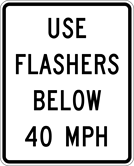 |
USE FLASHERS BELOW (__) MPH SIGN (R16-104) The Use Flashers Below (__) MPH Sign (R16-104) may be used on expressways and freeways at locations where trucks or other traffic may be traveling at a speed below 40 MPH on sections of roadway posted at 55 MPH or below 50 MPH on sections of roadway posted at 65 MPH. When used, the R16-104 sign should be placed at locations where some traffic may frequently be traveling at a speed less than the normal speed of traffic and where potential traffic problems exist. |
 |
THREE OR MORE AXLE TRUCKS SIGN (R20-4) (a) Justification. The Three or More Axle Trucks Sign (R20-4) may be used with other regulatory signs to prohibit trucks with three or more axles. (b) Placement. The R20-4 sign, when used, shall be mounted above other regulatory signs. |
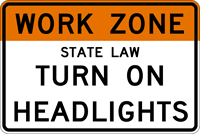 |
WORK ZONE — TURN ON HEADLIGHTS SIGN (R22-1) (a) Justification. The Work Zone — Turn on Headlights Sign (R22-1) shall be used in advance of work zones in accordance with Department of Transportation guidelines. When used, the R22-1 sign should generally be installed as the first sign approaching the work zone. (b) Size. The 72 inch x 48 inch size should be used for long-term operations on expressways and freeways. |

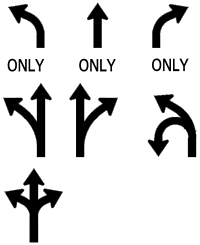
.png)
.png)
.png)